










Hey there, can you believe how fast the first half of the year has flown? I’m pumped for the approaching Olympics and can’t wait to cheer on our Aussie athletes in Paris. I have no doubt that many of our members will be tuning in, hitting the stands, or even competing. And, of course, there’ll be those lending their top-notch osteopathic skills to keep our athletes in top form at the 33rd Olympiad. If you’re involved in any official capacity, let us know so we can shout about the amazing impact osteopaths are making on the global stage. It’s been a whirlwind first six months for me as president, and I’m thrilled to share a major milestone: the launch of a brand-new course at Edith Cowan University in WA. This achievement aligns with our strategic goal of spreading osteopathic education across more Australian universities and targeting an increasing workforce distribution across the country. The course, the first new osteopathic program in Australia in over a decade, is a testament to our dedication. I extend my heartfelt gratitude to the Board, the executive team, and especially to
Osteopathy Australia
T (02) 9410 0099 E info@osteopathy.org.au
W www.osteopathy.org.au
osteopathyaustralia osteopathyau
osteopathyaustralia osteoaust
OSTEO LIFE is the quarterly magazine for Osteopathy Australia members. For enquiries, feedback, or to contribute, contact Communications on 02 9410 0099 or comms@osteopathy.org.au. For advertising enquires, email info@osteopathy.org.au.
Communications and Marketing Working Group
Tara Bain, Toby Barker, Adam Nicholson, Rebekka Thompson-Jones
Chief Executive Antony Nicholas
Editor Rebekka Thompson-Jones
Designer Stephanie Goh
Sub Editor Adam Scroggy
Advertising info@osteopathy.org.au
Printed by Megacolour
Printed on 100% recycled paper: one of our commitments to a sustainable future.
OSTEO LIFE is published by Citrus Media www.citrusmedia.com.au

“It’s been a whirlwind first six months for me as president, and I’m thrilled to share a major milestone: the launch of a brand-new course at Edith Cowan University in WA”
Michelle Funder and the other new course committee members Antony Nicholas and Brett Vaughan. Their hard work has paved the way for a new course, and they continue to collaborate with universities nationwide to introduce more new courses.
In April, our Board of Directors convened in Melbourne for a strategic meeting led by David Platt from Resilient Futures. This meeting was a deep dive into all things osteopathy and the association. The collaborative effort was instrumental in shaping our roadmap for the future, ensuring our agility, responsiveness and alignment with the needs of our members and the wider healthcare sector. I’m confident that the strategic moves we’re implementing will lead to more
resources for our members, more success for the association, and more relevance for our profession.
In February, Antony and I were lucky enough to be invited down to the Western Bulldogs to talk about further collaboration and opportunities for our members. We also observed the first cohort of osteopaths engaged in the Graduate Certificate of Strength & Conditioning, a program that equips osteopaths with advanced skills in sports medicine and injury prevention. It’s great to know that when the students participating in the certificate graduate, these osteopaths will gain direct Advanced Practice recognition through the association, opening new
(continued on page 4)
22 Reducing common complaints in osteopathy
Clinical
24
Rehabilitating Olympic athletes: the strategies for success
JASON IZYDORCZYK
26 Anterior cruciate ligament rupture: considering a nonsurgical management approach
LOUISE BIBBY & NICHOLAS TRIPODI
Careers
32 Working as an osteopath in sport: opportunity knocks DR PAUL HERMANN
34 CPD calendar
“Looking ahead, I’m excited for what’s on the horizon. Our first conference since the pandemic is fast approaching and I would like to personally invite all of you to come along to this event”
career opportunities. Partnerships like this between the association, Victoria University and the Western Bulldogs not only broaden our horizons, but also strengthen our ties within the healthcare community.
Over the past few months, I’ve had the pleasure of travelling around the country for our town hall meetings with our members. It’s been a joy to meet those who took the time to attend. Your feedback, challenges and ideas are the driving force behind our association, and I’m fully committed to ensuring your voices continue to shape our future. Your input is invaluable, and I encourage you
to keep the conversation going for more growth and collaboration.
Looking ahead, I’m excited for what’s on the horizon. Our first conference since the pandemic is fast approaching and I would like to personally invite all of you to come along to this event. It will be held in Sydney in late October (25-26). This conference will see Osteopathy Australia, Osteopaths New Zealand and the Osteopathic International Alliance join forces to put on a truly awesome event. I look forward to seeing you there!
Finally, as membership renewal comes to a close, I cannot stress more how
As a member of Osteopathy Australia, you can access incredible o ers and discounts which can save you over $2,000 each year.
Great discounts at some of Australia’s leading dining venues with promotions each month
New deals on hotels, holiday packages, hire cars and travel insurance
Discounts on fuel at Ampol, 7 Eleven, EG and Freedom Fuels
Access great value and a whole new level of cover from HCF, Australia’s largest not-for-profit health fund.
There are new o ers every month, so login and save with your Membership Advantage!
Terms & conditions apply to all o ers.
crucial your support is. We couldn’t do any of this without you, especially considering the challenges we’ve all faced over the past year. Massive thanks for your unwavering dedication and excellence. You’re the heart and soul of Osteopathy Australia.
Got questions, feedback or ideas?
Your input is not just valuable, it’s gold. Your thoughts and insights are what drive our association forward, and I’m eager to keep the conversation rolling for more growth and collaboration. Please, let me know your thoughts.
Enjoy the Olympics, and c’mon Aussies!
Matt Cooper President
Osteopathy Australia
mcooper.director@osteopathy.org.au
Osteopathy Australia acknowledges the Traditional Custodians and Elders of Country throughout Australia, and their connection to land, sea and community. We pay our respects to Aboriginal and Torres Strait Islander Elders, past, present and emerging.


OSTEOPATHY AUSTRALIA AIMS TO SUPPORT, ENHANCE AND PROMOTE THE PROFESSION. HERE’S A QUICK RECAP OF EVERYTHING OSTEO FROM THE PAST FEW MONTHS.

ANTONY NICHOLAS, CHIEF EXECUTIVE, OSTEOPATHY AUSTRALIA
Thank you to everyone who joined us at the nationwide town hall meetings over the past few months. These gatherings provided an excellent platform for us to share exciting updates about the new course development at Edith Cowan University, delve into our strategic planning processes, and engage directly with you. Your insights into what you value most, your aspirations for the future, and the essential services we must preserve have been invaluable and are now one of the driving forces behind our strategic planning. Your active participation is not just shaping, but also defining the future of your association and profession – which is the goal of our strategic plan. We truly value your input and consider it an integral part of our operations. Those who participated experienced first-hand a glimpse of the complex challenges that associations like ours navigate daily, particularly the tough decisions we must make within the constraints of a limited budget. Unlike
“Strategic planning is a vital tool for our professional healthcare association, enabling us to consider global, national, local and profession-specific factors”
some of our partner professions, we do not have 70 staff or a $20 million budget. Key questions we asked members to grapple with include: what are the most critical funding schemes to prioritise advocacy? If we can only support a limited number of services, which should they be? Perhaps our most daunting task is balancing 3,000 diverse individual perspectives to achieve the broadest positive impact for the majority of osteopaths. Your role in addressing these challenges is crucial, and we rely on your input to find the best solutions.
Strategic planning is a vital tool for our professional healthcare association, enabling us to consider global, national, local and profession-specific factors. This comprehensive approach is key to fostering an adaptable and responsive organisation, ensuring we can effectively anticipate and respond to changes in our environment and profession.
Globally, understanding international trends, regulations and advances in healthcare practices can provide a benchmark and inspiration for local practices, ensuring that the association remains at the forefront of the profession. It also highlights where Australian osteopathy is a world leader. Nationally, aligning with healthcare policies and economic factors helps advocate effectively for the profession and anticipate changes that could impact osteopathy. Locally, adapting strategies to
fit the unique cultural, economic and regional healthcare needs can enhance osteopathy’s relevance and the impact of the association’s activities. Most importantly, we can then focus on the professionspecific factors, including culture, connection, advances in research, changes in practice standards, and professional development needs to maintain the profession’s integrity and evolution. This comprehensive approach ensures that strategic planning is proactive and reactive, facilitating growth and sustainability in a dynamic, rapidly changing world and healthcare environment.
The ultimate aim of a strategic plan is to set clear shorter and longer-term goals or objectives for an organisation and to outline the specific strategies and actions needed to achieve these goals. Our developing plan, with your input, serves as a roadmap for guiding our direction over the coming years. Some of the strategies and actions we are considering include harnessing artificial intelligence and technology to deliver a better member experience. These are designed to optimise resources, enhance operational efficiency, and ensure alignment with our vision and purpose. Further, it helps to anticipate challenges, adapt to changes in the environment, and measure progress towards goals, ultimately fostering sustainable growth and success for osteopathy and osteopaths.
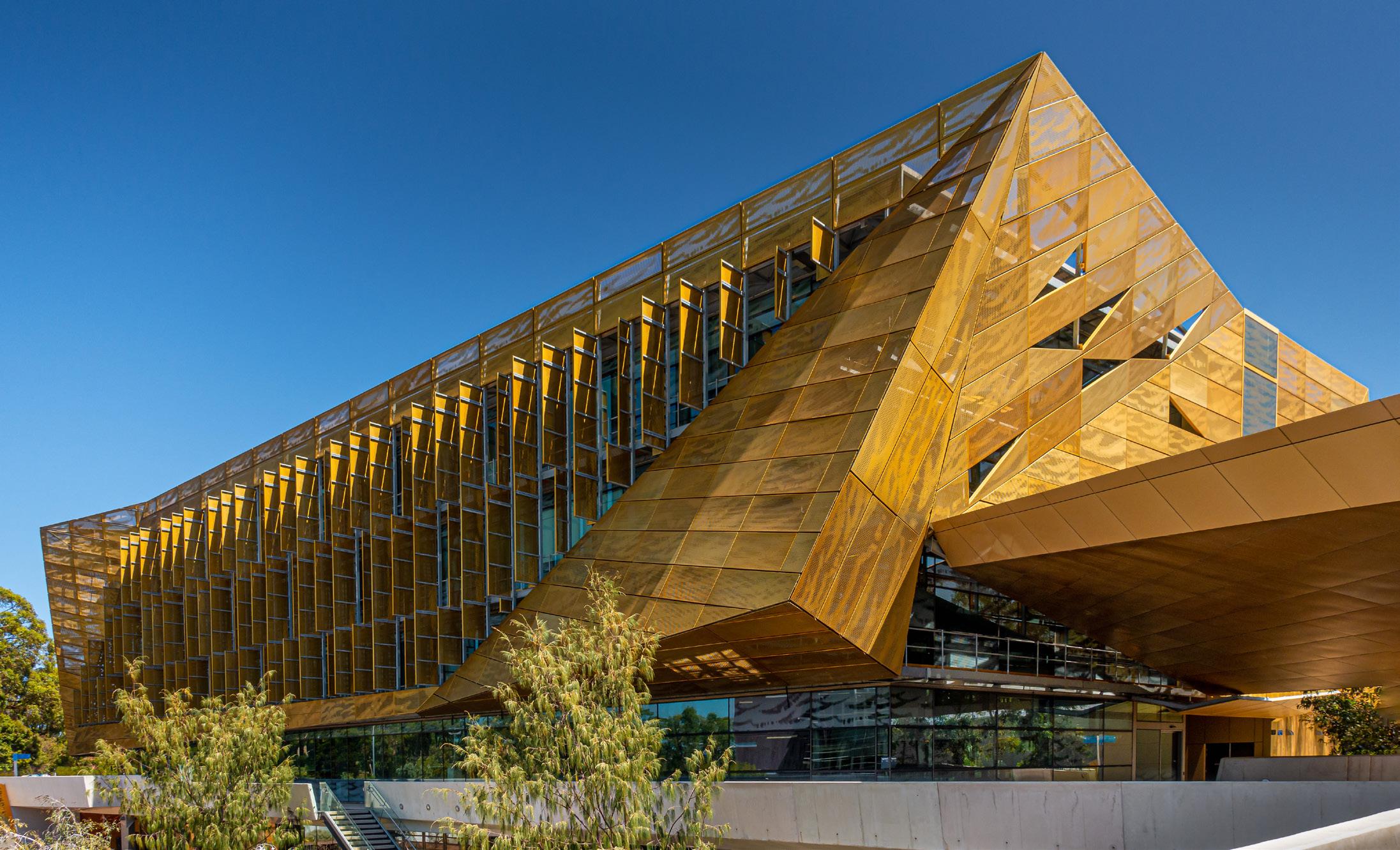
Edith Cowan University’s (ECU) recent announcement on developing a new osteopathy degree represents a landmark for Western Australia (WA) and the osteopathic profession. This new course is the first in WA and the first new Australian university offering osteopathy in over a decade.
Osteopathy Australia has played a pivotal role, advocating for the introduction of more university courses since 2019. ECU and Osteopathy Australia started productive discussions in 2022. This collaborative effort led to the development of the new osteopathy degree at ECU, a significant step in addressing the shortage of osteopaths in WA and enhancing the educational framework for osteopathy in Australia. We hope this achievement will inspire the launch of similar courses in other states. ECU will seek accreditation from the Australian Osteopathic Accreditation Council, with a plan to offer the three-anda-half-year Bachelor degree in the first semester of 2026 and a four-year Honours degree to high-performing students.
Executive Dean for the School of Medical and Health Sciences, Professor Moira Sim, said the ECU course is structured to ensure students can apply broad knowledge and theory of osteopathy in a range of clinical and practical situations and to think critically to analyse and interpret musculoskeletal conditions and factors that would impact treatment.
The introduction of the osteopathy course at ECU is a promising initiative set to enrich the healthcare landscape by training osteopaths equipped with the knowledge and skills necessary to meet the growing demand for whole-body approach health solutions. The development of this course is also expected to stimulate local interest in osteopathy as a career, contributing to the sustainability and growth of the profession. It holds the potential to encourage more research, create new career opportunities, and further advance the field of osteopathy, aligning Osteopathy Australia’s ongoing efforts to enhance professional standards and ensure osteopaths continue to play a critical role in public health.
The introduction of the osteopathy course at ECU is more than an educational milestone; it’s a step towards filling the significant void in the healthcare services of WA, directly benefiting the community by providing accessible, high-quality osteopathic care.
Osteopathy Australia would like to express its gratitude to the New Course Committee for its invaluable contributions. Michelle Funder, former President, has chaired the committee with dedication. She and Brett Vaughan, former AOAC Chair and Melbourne University academic, have each brought their expertise to the table.
Antony Nicholas, Osteopathy Australia CEO, has been instrumental in guiding the course development. Their collective efforts over the past several years have made this a reality.
Mr Nicholas noted that numerous health practices and organisations across Western Australia have highlighted significant challenges in recruiting osteopaths, a concern underscored by the modest increase of only eight practitioners in the local workforce over the past five years.
April 2024 was a significant milestone for the osteopathy community as we celebrated the first Osteopathy Awareness Month. Your concerted effort to raise awareness and educate the public about the benefits of osteopathy, through active engagement and sharing of your stories on social media using designated hashtags, made an impact! The overwhelming positive response has showcased not only the strength and unity within our community, but also the power of your individual contributions, each of which played a crucial role.
Throughout the month, you shared your passion for osteopathy through various platforms. We recorded an impressive 194 Instagram posts under the #OsteopathyAwarenessMonth hashtag. This number doesn’t even include posts where we weren’t tagged, indicating a wider reach
than our initial estimates. On Facebook the engagement was equally robust, with 120 posts either using the hashtag or tagging us directly. Additionally, we saw an estimated minimum of 100 story and video shares on Instagram, further amplifying our message.
Osteopathy Awareness Month was a testament to the power of teamwork; not just member participation, but also a coordinated effort from the communications team, who meticulously planned and executed two to three weekly posts on all our public channels incorporating a mix of boosted ads, videos, infographics and blog posts. This strategic approach paid off, as illustrated by the engagement metrics.
Our public posts saw a remarkable 178% increase in total engagements. The content resonated well with the audience, leading to a 77% rise in shares. Impressions went up across the social channels with
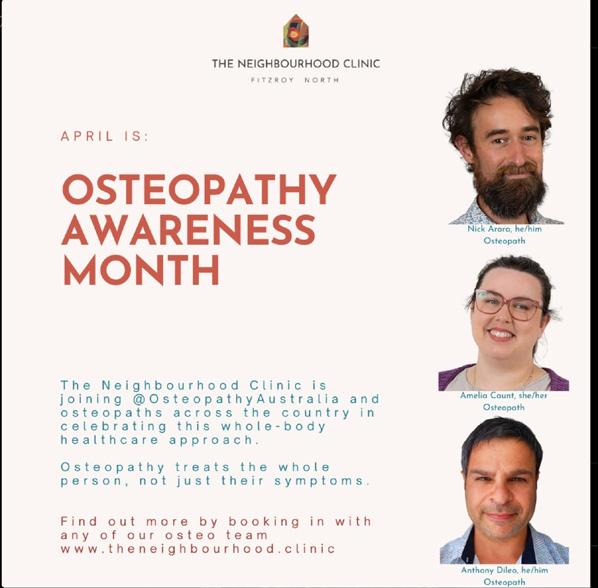


194 posts shared under the hashtag #OsteopathyAwarenessMonth, plus at least 100 stories.
93,341 Facebook impressions, as well as 23,837 Instagram accounts reached with 56,280 Instagram impressions. Perhaps most notably, the number of link clicks skyrocketed by 700%. These metrics reflect our campaign’s effectiveness and highlight a growing public interest in osteopathy.
The success of this inaugural Osteopathy Awareness Month is a testament to the dedication and enthusiasm of you all and the broader osteopathy community. The stories, posts and shares have helped to shine a light on the important work osteopaths do and the benefits they provide to patients. As we move forward, we’re excited to build on this momentum and look forward to continuing to elevate the profile of osteopathy with your continued support and engagement. Thank you to everyone who participated and made the first Osteopathy Awareness Month successful. Here’s to many more!
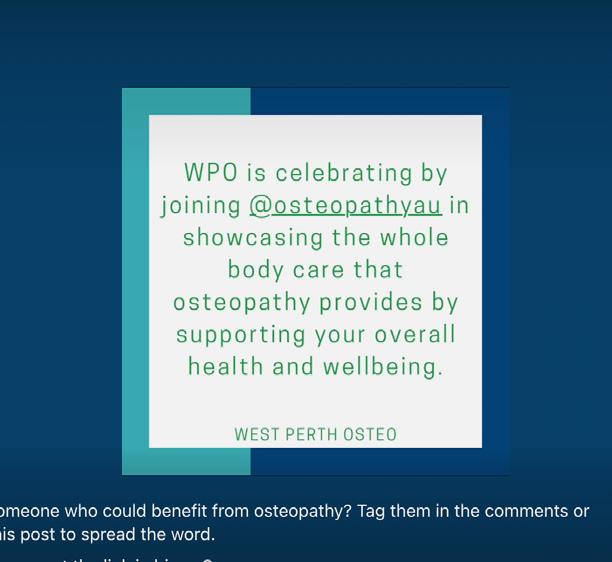

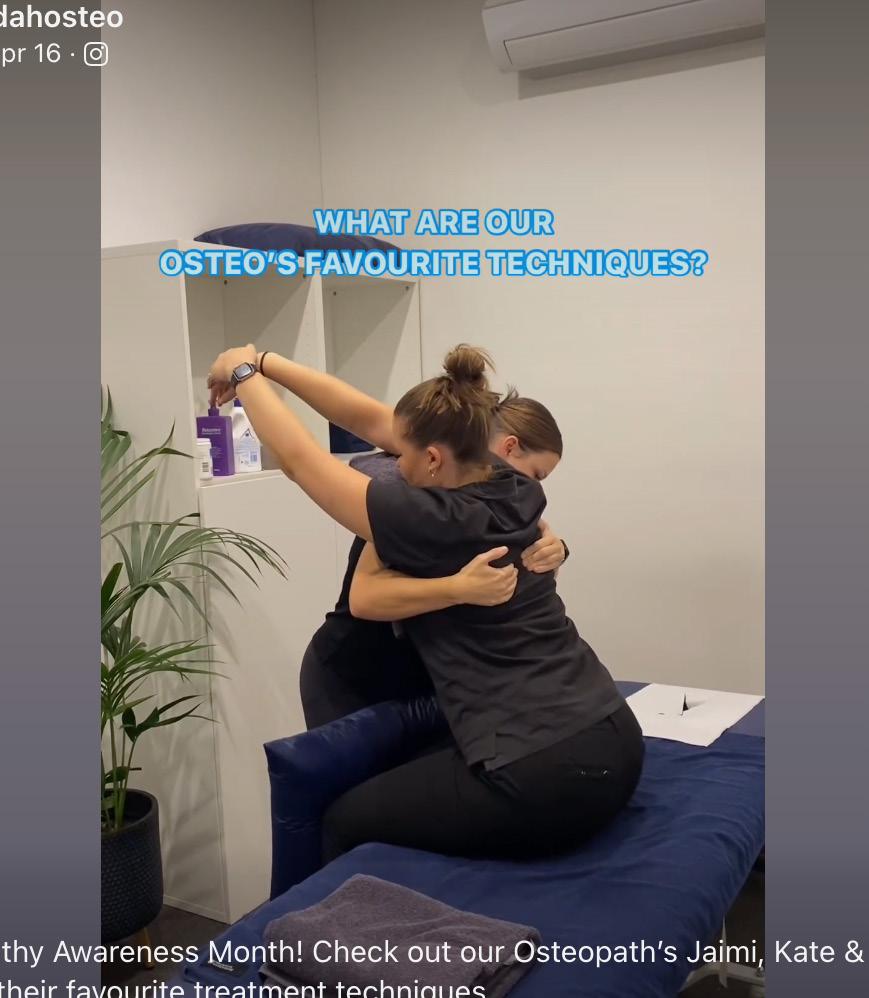
With nearly a quarter of Australians participating in sports or physical activities, the sports and athletics sector provides a great opportunity for osteopaths to build their business and make a difference in patient outcomes.
Each week at least 70,000 Australians seek osteopathic consultation, many of whom require assistance with a sportsrelated clinical concern. As primary healthcare practitioners, osteopaths can play a vital role in identifying and mitigating injury risk factors, improving sport and athletic performance and facilitating optimal injury management in collaboration with a multidisciplinary team.
An Osteopathy Australia titled ‘Advanced or Extended Sports Osteopath’ is an osteopath who can demonstrate a long-term commitment to sustained practice in treating and managing sports injuries and athletic performance through continued educational development and in clinical practice.
They will possess specific skills in all areas of sporting performance, including but not limited to:
Skills in biopsychosocial management protocols, self-management strategies and capability improvement programs to support biomechanical requirements in sport;
Exercise programming to rehabilitate and help reduce the recurrence of sporting injuries;
An extensive understanding of pain and performance patterns that preclude sporting participation and/or predispose athletes to injury during play;
Understanding of all the intrinsic and extrinsic contributors associated with common injuries to help maximise performance and minimise the effects of sporting injuries;
Titled osteopaths have completed extensive further study and proven work experience in their field and have been independently assessed to meet the required standard.
Our Advanced and Extended Practice sports team is committed to providing patients with the highest-quality care. Their diverse expertise in a range of sports management and performance areas ensures that each patient receives the best possible treatment, instilling a sense of reassurance.
The Advanced Practice Sports Pathway is designed for osteopaths pursuing advanced skills in sports medicine. Their comprehensive training and experience allow them to approach patient care with advanced diagnostic techniques, therapeutic interventions, and rehabilitation strategies that help athletes maintain peak physical condition. Advanced Practitioners will have obtained additional tertiary qualifications in sports management or be able to demonstrate comprehensive experience in the sector.
Osteopaths who pursue Extended Practice have developed their knowledge and skills beyond the traditional scope of practice and actively work alongside other healthcare professionals to incorporate innovative treatments and strategies. They are equipped to provide care that guides athletes towards peak performance and effectively manage acute and chronic conditions.
The Advanced and Extended Practice recognition program acknowledges osteopaths who have expanded their qualifications and skills. This recognition benefits practitioners with the following: Enhanced referral networks and professional visibility; Improved career opportunities within and outside osteopathy; Peer and public recognition; Networks for sharing knowledge and growth.
Other recognition programs
Advanced Practice recognition can be gained in the following areas: Paediatrics Sports Management Exercise-based

Introducing the Advanced and Extended Practice sports team, a group of highly qualified healthcare professionals.
Practice
LOUISE BIBBY
“I didn’t initially choose to be a sports osteopath; the career path naturally evolved over my first decade in practice. Working in rural areas, I faced many challenges, including limited access to sports doctors, surgeons, radiology, performance and rehabilitation services. These challenges drove me to rapidly collaborate and advance skills in injury assessment, orthopaedics and sports medicine. I developed skills in advanced and accelerated rehabilitation strategies out of necessity, becoming a versatile practitioner for a diverse demographic. This unique journey fuelled my passion for sports osteopathy, nurturing valuable sports medicine industry networks, and the desire to provide comprehensive care to athletes of all ages and abilities.”

KEVIN JAMES
“Do your clients rest after an injury, only to get injured again when they return to their sport? I experienced this for years as an elite gymnast and as an osteopath. Determined to find a better way, I delved into coaching, attending and presenting at state, national, and international courses. I consulted in various sports and designed a course for Artistic Swimming Australia, focusing on evidence-based teaching, biomechanics, performance and injury safety. Now, I work with local sports clubs, surfers and ballet dancers in the Bass Coast Shire (Phillip Island), conduct research at UniSA via a Master of Research degree, and educate/supervise RMIT’s osteopathic students. Becoming an advanced practitioner signifies my commitment, innovation and excellence to the osteopathy profession.”
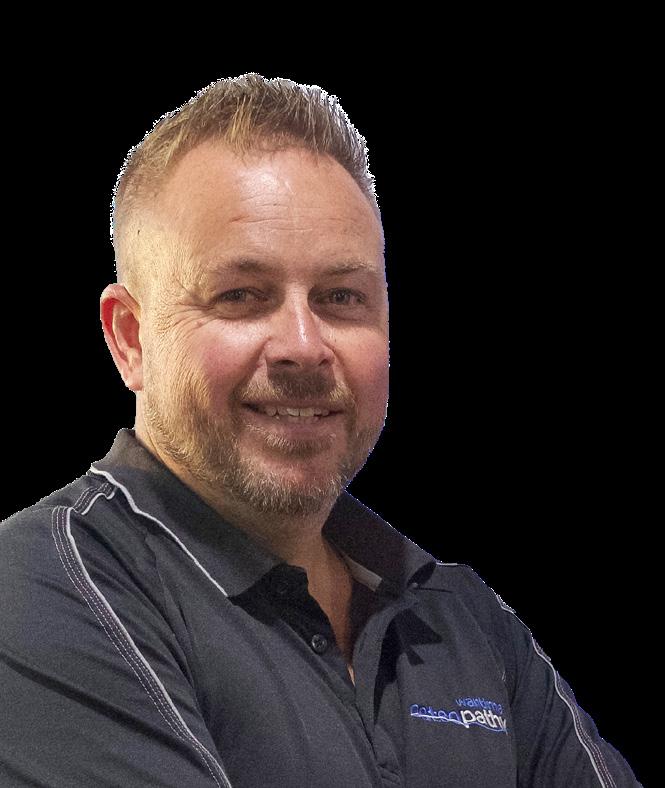
BRUCE DUNCAN
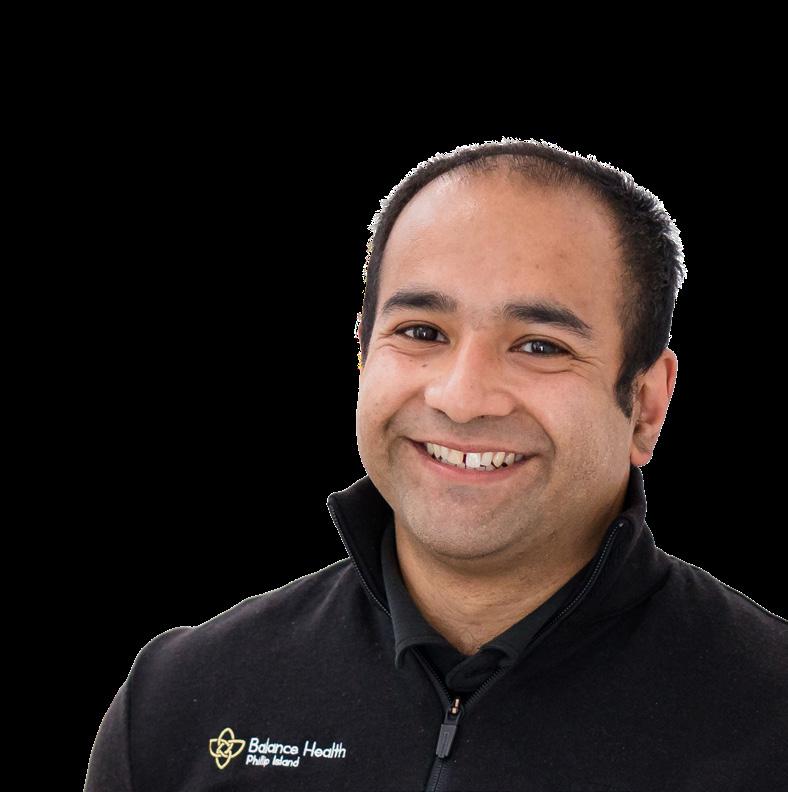
“As a high school sports enthusiast who would engage in any sport and even watch two flies race up a wall, it was inevitable that sport would feature in my working life. Studying exercise science (Human Movement) in the early ’90s and dealing with multiple injuries playing Australian Rules footy, my interest in sports medicine grew. Frustration with recurrent injuries and the flaws in my management led me to discover the whole body approach of osteopathy. I saw how osteopathy could significantly contribute to sports injury management at all levels. As an osteopathy student, I held a head sports trainer role at a VFA/VFL football club. Over the years, I held multiple head medical roles at local football clubs, mentoring many student osteopaths in sports trainer roles. Osteopaths in these roles thrive from the experience, build a trusted reputation, and help our profession gain acceptance and respect. In Australia, sport is beloved, and osteopaths’ involvement in sports is crucial for our growth and long-term existence. For these reasons, I am proud to be one of the few titled Sports Osteopaths and hope many more will follow.”
“My first serious sports role was as an osteopath for the Australian Aerobics Team in the early 2000s. Tennis has been my main sport personally, and I’ve worked with tennis athletes for 30 years, serving as an osteopath at the Australian Open for over 20 years. Since 2015, I have been involved in the AFL world, formally with the Hawthorn Football Club, and consulting to the Carlton Football Club. I was part of Osteopathy Australia’s Sports Clinical Practice Group, which established the Advanced Sports Recognition pathway. I completed this accreditation in 2020-21 to enhance my position in professional sport, prepare for future opportunities, upskill in new areas, and support the initiatives of Osteopathy Australia.”


“Having been interested in Sports and Exercise Rehabilitation my whole life, it was a natural progression to continue my studies and develop my skillset in these areas. It’s been fantastic that my additional qualifications at university, extensive CPD and experience have enabled me to be titled as an Advanced Practitioner in both Sports and Exercise Rehabilitation. It has been very well received and regarded by the general population and athletes I consult with as patients, and the physicians, surgeons and specialists with whom I regularly work. Thank you, Osteopathy Australia, for establishing and maintaining this program.”
JEROME SMITH
“Originally from the UK, I completed my training at the British School of Osteopathy in London and have since practised as an osteopath in Australia for almost 10 years. I’ve been fortunate to work across a variety of clinical settings including multidisciplinary private practice, pitch-side sports settings and a private hospital providing post-operative rehabilitation. In sport, I have worked largely in men’s and women’s soccer with clubs in the ACT Capital Premier League and National Premier League Women’s soccer competitions. As part of my interest in the sport, I also completed an online Diploma in Football Medicine through FIFA. I currently work in private practice in Sydney with a keen interest in lower limb overuse injuries such as tendinopathy and plantar fasciitis.”

As we enter the second half of 2024, I invite you to join me in reflecting on the significant strides we have made over the year. Since stepping into the role of president in January, I’ve had the privilege of witnessing and leading our collective achievements. This past year has been filled with remarkable milestones, and as the membership renewal period draws to a close, we are reminded of the importance of our journey together.
Voice of osteopathy: representation and lobbying
Our dedicated representation and lobbying efforts have ensured that your voice is heard at the highest levels. We have actively engaged with policymakers and advocated for the interests of osteopaths. By maintaining a strong presence in the healthcare policy arena, we have aimed to influence decisions impacting our practice, ensuring osteopathy remains a vital and recognised part of the healthcare system. Your membership funds these essential activities, reinforcing the collective strength of our profession.
Professional support: advice and assistance
Throughout the year, our team has been ready to provide personalised advice and assistance, addressing your concerns and helping you navigate the professional landscape. Whether you needed guidance on practice management, regulatory requirements, or clinical queries, the team were and are just a phone call away. We understand the challenges you face, and we remain committed to offering the support you needed to thrive in your practice.
Empowering you: the launch of the member assistance program
First on our list of achievements is the introduction of the Member Assistance Program. This counselling service has become a cornerstone for members seeking support – whether they need professional guidance or simply a listening ear. The widespread utilisation of this service underscores its value, making it a proud addition to our member benefits.

innovation: the Osteopathy Australia Research Fund
The Osteopathy Australia Research Fund has been a beacon of progress, distributing grants to propel research that advances our profession. This year, we’ve seen unprecedented investment, affirming our commitment to fostering a research-rich culture within our community.
Educational excellence: CPD and beyond
Our ongoing commitment to education continues to shine with a wide array of eLearning modules and CPD opportunities. From mandatory courses for registration to special interest topics, we’re helping our members meet and surpass their professional development goals monthly.
skills: Postgraduate Certificate in Strength and Conditioning
In partnership with Victoria University and the Western Bulldogs Football Club, we’ve launched the Postgraduate Certificate in Strength and Conditioning. Our members comprised 35% of the inaugural enrolment, a testament to our dedication to advancing clinical practice through postgraduate education.
University collaborations: expanding horizons
Our engagement with leading institutions like Victoria University, RMIT and Southern Cross University has never been stronger. And in May 2024, we were delighted to announce that Edith Cowan University (ECU) will become Western Australia’s first osteopathy educator. These collaborations are paving the way for future expansions and innovations in osteopathy education and practice across Australia.
A call to action: renew and connect
As we forge ahead, the importance of membership renewal cannot be overstated. Our efforts to maintain osteopathy’s prominence in the healthcare sector are fuelled by your continued commitment. The upcoming conference, our first post-COVID gathering, promises to be a landmark event, reigniting connections and introducing cutting-edge insights in our field.
Join us in shaping the future
Renew your membership, encourage past members to rejoin, and help us maintain the momentum that makes osteopathy an indispensable part of Australian healthcare. Together, we will continue to strengthen our profession for years to come. Thank you for your steadfast support and dedication.

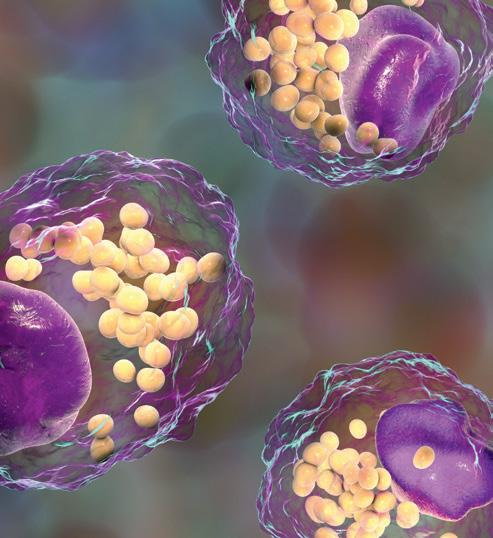
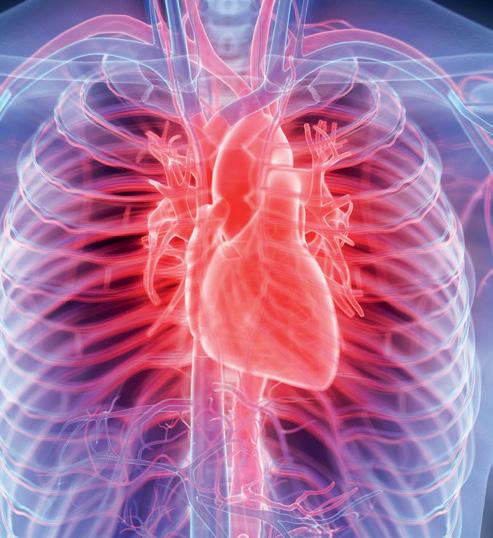

Key features and benefits
• Herring roe is a natural source of specialised pro-resolving mediators, with minimal processing required.
• Relieves inflammation.
What are SPMs?
Specialised pro-resolving mediators (SPMs) are lipid mediators synthesised from omega-3 fatty acids EPA and DHA, that are imperative in the resolution phase of inflammation.
• Specialised pro-resolving mediators are used in the body’s natural inflammation resolution process.
• Supports cardiovascular system health.
UC PROMEGA DIFFERENCE
A low-excipient, bioefficient phospholipid form of broad spectrum omega-3 SPMs, including 18-HEPE, 14-HDHA, 17-HDHA and RvE2
INFLAMMATION RESOLUTION
SPMs actively promote the resolution of inflammation and restoration of homoeostasis. Endogenous SPM production may be impaired by inflammation and ageing
NATURAL SOURCE
Sustainably supplied Norwegian herring roe is a natural source of SPMs, with minimal processing required
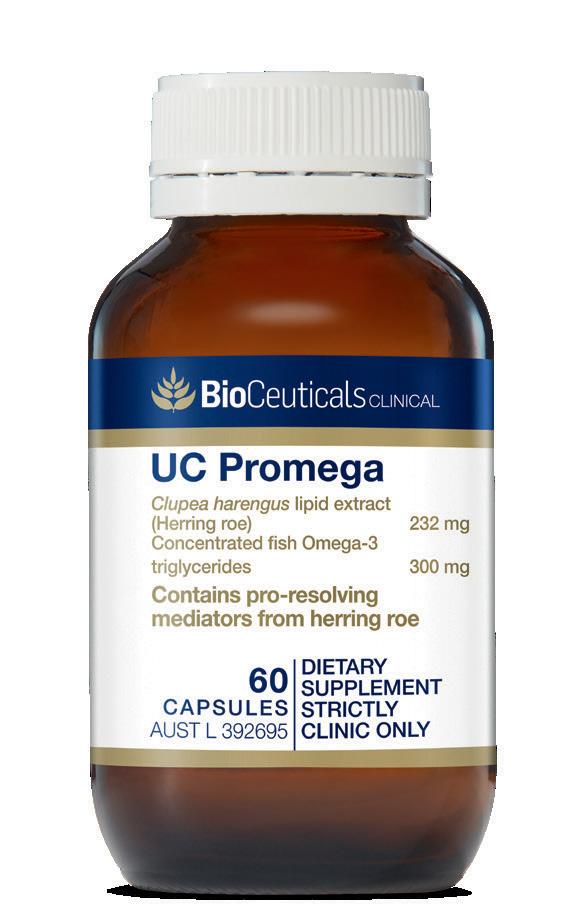
DOSE: Adults: Take 1 capsule one to four times a day, or as professionally prescribed.

There will be an added buzz this spring in Australia’s premier harbourside city, Sydney! The Asia-Pacific’s leading networking event for osteopaths is coming to town; tickets are now on sale for this widely anticipated event.
Being the leading networking event for osteopaths in Australia and New Zealand, the conference will allow you to meet like-minded practitioners from around the world and across Australia while attaining the bulk of your annual CPD hours in just two days.
To help celebrate the occasion, the Osteopathic International Alliance (OIA) is proud to conjointly host the 2024 Osteopathy Conference over two days with Osteopathy Australia and Osteopaths New Zealand.
The conference will be held on 25-26 October at Sydney Central Hotel. Close to Sydney’s bustling Asian dining precinct, theatres, and Darling Harbour, the Sydney Central Hotel (formerly the Novotel Sydney Central Hotel) is the ideal venue to showcase new and emerging osteopathic, health and wellbeing practices.
Under one roof, you will have the opportunity to hear from speakers
from across the globe, attend and immerse yourself in exciting workshops, meet clinical vendors and benefit from the knowledge of leading-edge and contemporary practices.
The OIA will be co-hosting the plenary sessions. The conference features speakers and delegates from the United States, South America and Europe, while Australia will boast leading-edge abstracts from clinicians, researchers, academics and thought leaders, ensuring all your practitioner bases are covered.
By fortunate coincidence, 2024 also marks the 150th anniversary of the
creation of osteopathy by the first osteopath, Andrew Taylor Still. Still, an American physician and surgeon, started the practice of osteopathy in 1874, and in 1892 he established a university in Missouri, now known as A.T. Still University, which became the first osteopathic institution in the world.
Early Bird registrations are open until 7 August 2024, offering discounted ticket prices. Additionally, all delegates can enjoy reduced accommodation rates at the Sydney Central Hotel (subject to availability). Please contact the hotel directly to secure your booking.
Inclusive of morning registrations, the conference will run from 8am to 5pm on Friday 25 October and 8:30am to 5pm on Saturday 26 October. A Welcome Reception will also be held from 6pm to 8pm on Friday 25 October. Times are subject to change without notice.
Note: The full conference program, which includes all speakers, topics and workshops, will be available on our website shortly.



International concern is growing about those at risk of multiple concussions and repetitive neurotrauma in sports. Hear why Australia’s contact football codes are worried.
Keynote speakers, Eminent Associate Professor Michael Buckland, along with Professor Alan Pearce and Dr Andrea McIntyre (Osteopath), will give a lecture on the latest research on the signs and symptoms, the underlying physiology and neuropathology, and the first-hand lived experience to inform osteopathy practitioners working with patients exposed to repetitive neurotrauma.
Associate Professor Michael Buckland is a senior neuropathologist and the Head of the Department of Neuropathology at Royal Prince Alfred Hospital, Head of the Molecular Neuropathology Program at the Brain & Mind Centre, University of Sydney.
Professor Alan Pearce is a clinical neurophysiologist with 25 years’ experience.
Dr Andrea McIntyre (Osteopath) is a practising osteopath in Melbourne. Andrea draws on her expertise as an osteopath but has also lived the experience of a loved one passing away with chronic traumatic encephalopathy (CTE). Andrea aims to increase awareness and understanding of CTE through the osteopathy community.
In the year osteopathy celebrates 150 years as a medical profession, hear how Australia’s osteopathic identity has evolved greatly over the last century and where the profession is heading.
Keynote speaker, Associate Professor Gary Fryer is the course chair in osteopathy at Victoria University, Melbourne, Australia, and he has advocated for an evidence-informed approach to teaching and practising osteopathy.
In 2017, a senate inquiry was undertaken after hundreds of Australian women reported serious pelvic pain and side effects from the use of transvaginal mesh implants, including incontinence, dyspareunia, severe chronic pain, and the inability to sit and walk. Hear how education and dual consults can improve patient outcomes.
Dr Amy Corcoran (Osteopath), an advanced pain management osteopath and pain educator, discusses the customised clinical approach to maximising patient outcomes through neuroscience-based pain education and integrating dual consults with all patients presenting with persistent pelvic pain.
Breast cancer is the most commonly diagnosed cancer among women in Australia, with over 20,000 Australians diagnosed with breast cancer each year and around nine Australians a day dying from the disease. Hear one of Australia’s leading minds on breast cancer trauma, Dr Amanda Hannaford (Osteopath), talk about why osteopathy is ideally suited to address breast cancer treatment side effects such as scarring, cording, seroma, adhesions, and fibrous tissue changes, and how osteopathic techniques work to unwind and soften scarred and thickened tissue.
As medicinal cannabis continues to shape the landscape of healthcare around the world, hear how allied health professionals, including osteopaths, play a pivotal role in harnessing its therapeutic potential.
Dr Brett Wiener (Osteopath) will unlock actionable insights and best-practice techniques so that osteopaths can confidently integrate medicinal cannabis considerations into osteopathic practice, fostering informed decision-making and personalised
patient care. By bridging the gap between regulatory frameworks and clinical application, you will find out how osteopaths will be equipped to navigate barriers to access, address patient enquiries, and collaborate effectively within multidisciplinary care teams.
Would you consider suggesting minimalist footwear to reduce patellofemoral joint loads during running, which may reduce patellofemoral pain symptoms? After this talk, your answer will probably be yes.
Dr Sam Kayll (Osteopath) gives a fascinating insight into footwear and insoles, which have been proposed as low-burden treatment approaches that may reduce patellofemoral joint loads and improve symptoms. This presentation gives a systematic review and meta-analysis that investigated the effect of footwear and insoles on patellofemoral joint loads in adults with and without patellofemoral pain and osteoarthritis.
Patellofemoral pain syndrome (PFPS) is one of the most common causes of knee pain present in females. It is also known that females with PFPS demonstrate a decrease in abduction, external rotation and extension strength of the affected side compared with healthy patients.
Dr Andrew Timos (Osteopath) will talk about the current concepts surrounding

the effect of knee valgus during lower limb dynamic movements and its relationship to PFPS. His talk will also include the predisposing factors to this injury, how to address the biomechanical compensations, and rehabilitation techniques to improve lower limb positioning and reduce PFPS symptoms.
Shoulder impingement syndrome (SIS) is a common and difficult presentation for allied health practitioners. But should it be?
Dr Don Hunter (Osteopath) talks about how shoulder function is related to thoracic posture and whether the osteopathic technique, known as muscle energy technique (MET) to the thoracic spine, improves the pain and disability of SIS patients when compared to placebo.
Data and AI are possibly the two biggest considerations every business will need to harness and understand if they are to remain
competitive in an ever-changing dynamic and uncertain environment. Joel Friedlaender is a software developer and founder of Cliniko, a world-leading practice management software platform that benefits over 100,000 users worldwide. Hear why and how data and digital security are central to achieving regulatory best practice, compliance and, importantly, privacy in the health sector. Additionally, understand how AI should be considered a friend, not something you fear.
Many thanks to our conference sponsors for their continued support of our members and helping make our conference possible.

Cliniko was founded in Australia over 10 years ago. Its practice management software is used in over 5,000 clinics and in more than 70 countries worldwide, one of the many reasons it is proudly recognised as a carbon-neutral company. Based on an ethos of inclusion, diversity and respect, its corporate responsibility sees that 2% of its customer subscription fees are donated to charity.
With Cliniko’s intuitively designed software, practitioners can easily manage their busy schedules, utilise fully customisable treatment notes and process financial matters such as invoices and taxes. Cliniko’s powerful reporting features allow practice managers to easily view and analyse practice revenue, growth, stock levels, client spending and more. All these features and many more allow practitioners to focus their energy where it belongs – with their patients.

The DrRest Sleep System is the culmination of health expertise, research and real-life experience of a team driven to see people experience the benefits of quality rest. Their innovative, patented
mattress is available for everybody to experience better rest.
Founded from a need of real-life issues associated with a lack of quality sleep and musculoskeletal rest, DrRest health experts undertook exhaustive medical literature research combined with their respective clinical experience to design and configure a mattress that ergonomically responds to any body size, shape or weight to align the spine for rest.
DrRest is Australian owned and manufactured in Melbourne, Australia.
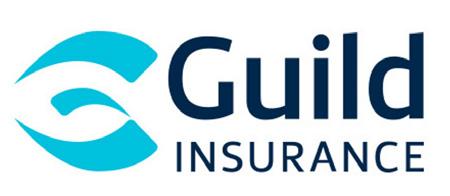
Guild Insurance, gold sponsor
Established in 1963 by the Pharmacy Guild of Australia, Guild Insurance has proudly continued the pharmacist’s ethic of honesty, integrity and professional excellence to this day. Working with over 130 associations and insuring over 80,000 customers across Australia, Guild Insurance holds a mantle of still being 100% Australian-owned and an APRA-regulated insurer. Winning a recent Small General Insurer of the Year award at the Australian Insurance Industry Awards is a testament to the culmination of dedication, expertise, experience, and level of trust Guild has forged with small business owners and practitioners across Australia.

OPC Health is a preferred supplier with major hospitals, allied health services, and government bodies. For over 40 years, it has committed to serving prosthetic, orthotic, and allied health professionals across Australia and New Zealand. With the ability to provide end-to-end solutions for prosthetic/orthotic clients, OPC Health’s extensive product knowledge and clinical expertise enable them to source, manufacture and develop the best product treatments from around the world. From musculoskeletal bracing and prosthetic limbs to compression garments and clinical supplies, you can rely on OPC Health for all your healthcare needs.

Please refer to the conference hub on our website to purchase tickets.
Early bird two-day
Two-day member
Two-day early bird graduate
Two-day graduate
One-day general
Two-day non member
$850.00
$990.00
On sale to 7 August 2024
$700.00 On sale to 7 August 2024
$850.00
$630.00
$1,300.00
All member categories. Not available to non members
Clinic offer: purchase two or more tickets in a single transaction and receive 15% discount off each eligible ticket price. Email info@osteopathy.org.au to take advantage of this offer
All prices are inclusive of GST
All tickets purchased are subject to our conference ticket terms and conditions for Osteopathy Australia Conference 2024

The conference is being held at the Sydney Central Hotel (formerly the Novotel Sydney Central Hotel), which is located at 169/179 Thomas Street, Haymarket, Sydney.
The hotel is a five-minute walk from Central Station.
Alternatively, the light rail goes from Central Station to Haymarket, where visitors can alight and take a 10-minute walk through parts of Chinatown to the Hotel.
The hotel is a three-minute walk from bus stops on Parramatta Road where it morphs into George Street.
Conference delegates will be entitled to receive a discount of 10% off the best available rate, subject to room availability. You will need to email or call the Sydney Central Hotel and quote the code OSTEOOCT23 to receive the discount.
To make a reservation at the hotel, email reservations.sch@the-ascott.com or call +61 2 9281 6888.
Note: The code cannot be used through the Hotel’s online reservation page.
Delegates can also receive a discounted rate for parking at the hotel. Parking is $30 for day use and $45 for overnight. After
you have parked, you will need to go to the Hotel reception and make them aware that you are attending the conference and you will get your parking ticket validated.
There is also parking at First Parking Darling Square, entry via Zollner Circuit. This is around a 15-minute walk from the Sydney Central Hotel. Please visit www.firstparking.com.au. No discounts apply to this parking.
What better way to take in the sights and senses that make Sydney the place to be this October? We look forward to seeing you there.
For further information, please email cpd@osteopathy.org.au
Dr Shamona Eaves encourages you to join Osteopathy Australia’s digital PROMs pilot, seamlessly integrating into clinical workflows. Benefit from training and discounted subscription fees, and contribute to advancing patient-centric care and professional standards.
(PROMs) represent a pivotal shift towards patient-centric healthcare, capturing a patient’s perception of their health conditions and the effectiveness of medical interventions. By directly reflecting the patient’s voice, PROMs mitigate the influence of professional bias, providing a transparent framework for assessing improvements in health and quality of life.
These tools are not only diverse, covering a broad spectrum of conditions and demographics, but are also highly adaptable, available in both generic and condition-specific formats.
PROMs may focus on singular aspects such as pain, or encompass a range of indicators including mobility, and overall life quality, administered via user-friendly paper-based or electronic methods to enhance compliance and usability for practitioners and patients
Recently, there has been a significant push towards integrating PROMs into value-based care models, advocating for their routine use across health systems. This aligns with the initiatives by Osteopathy Australia to embed PROMs within osteopathic practice, reinforcing evidence-based practice, advancing the profession’s credibility and, ultimately, improving patient outcomes. The use of PROMs not only supports safer and more effective delivery of care, but also empowers patients to actively participate in their health management, fostering a collaborative health journey.
Osteopathy Australia is committed to facilitating the widespread adoption
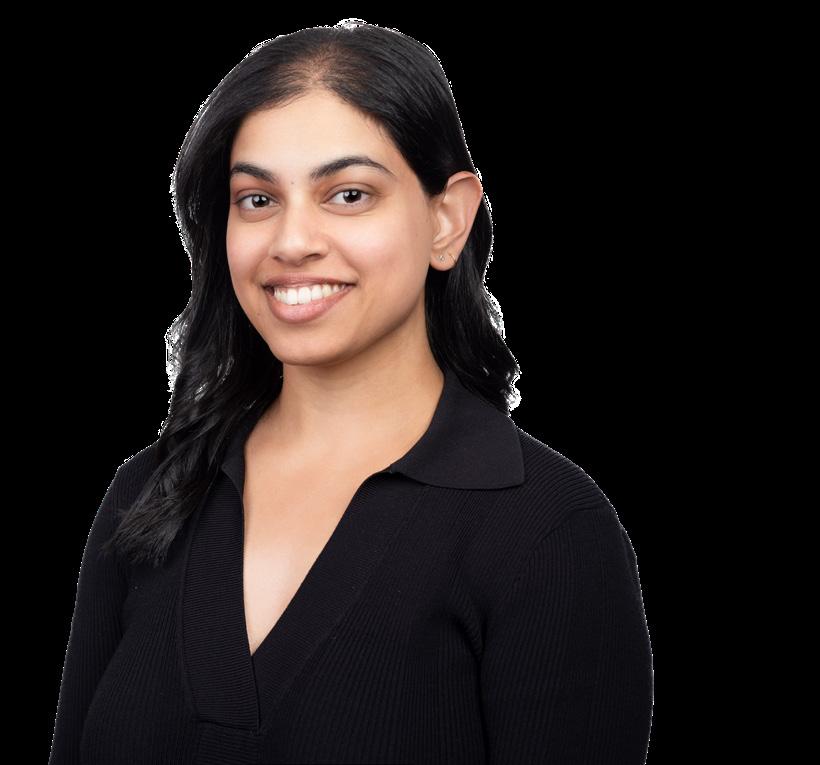
“In an exciting development, Osteopathy Australia invites you to participate in a pilot program that integrates digital PROM collection into everyday clinical practice”
of PROMs among osteopaths. We have provided a selection of outcome measures, available on our website, with validity scores and user instructions. These resources are accessible, offering PDFs and online formats for download that simplify the data collection process. Visit www.osteopathy.org.au/research/ patient-reported-outcome-measures.
In an exciting development, Osteopathy Australia invites you to participate in a pilot program that integrates digital PROM collection into everyday clinical practice. This initiative conducted in collaboration with Physitrack, a leader in digital exercise and PROM solutions, focuses on gathering de-identified data from patients with knee, hip and back complaints. The trial is designed to integrate seamlessly into existing clinical workflows, minimising disruption while maximising research and policy insights. Participating osteopaths will receive training on assigning PROMs to patients via the Physitrack platform, and the data will be automatically de-identified, aggregated and exported to Osteopathy Australia.
Participants in the pilot will benefit from reduced subscription fees to the Physitrack platform, a discounted rate of AUD $14.99 per practitioner per month instead of the usual AUD $19.99*. This collaboration not only aids in data collection, but also supports ongoing professional development and practice enhancement.
For those interested in contributing to the project, further details are available on our website, including comprehensive Practitioner and Patient information sheets, at www.osteopathy.org.au/ article/proms-pilot-2024. Enquiries can be directed to Dr Shamona Eaves, Senior Research and Project Officer, who is available for further information and support via seaves@osteopathy.org.au or 02 9410 1699.
By participating in this initiative, osteopaths have a unique opportunity to contribute to the broader application of PROMs in healthcare, driving improvements in patient care and professional practice standards across Australia. Join us in this innovative endeavour to shape the future of osteopathy.
* This study has received ethics approval from the Victoria University Human Research Ethics Committee (VUHREC). Please note that practitioners must cover the cost of their subscription for the duration of the trial.
Former Australian rules footballer Anthony Koutoufides played over 270 games for Carlton Football Club and remains a legend of the game. His retirement decision was made in 2007 after he suffered a degenerative shoulder and a hip injury that was discovered to be more severe than first expected.
You’ve recently had shoulder surgery. What led to that decision?
Doing the shoulder replacement was a big decision for me and definitely not an easy one. Having exhausted non-invasive surgical options such as stretching, strength training and acupuncture, my lack of mobility and increasing pain were obvious reasons why I needed the surgery.
Before the surgery, was it difficult to find a comfortable position to sleep?
Yes, I was unable to sleep on my right side, my bad shoulder, it was very difficult. At times I would wake up in pain and it felt like my shoulder joint was like glue – it was immobile and stuck together. At times I used to also get numbness in my right arm. There was definite discomfort. If I turned or made a sharp movement, there was pain and I often had disrupted sleep.
DrRest has been a part of your rehab and recovery - what gave you the confidence to try the mattress?
What appealed to me about DrRest was the choice of technology within the mattress's materials. For example, I found the Technogel in the shoulder zone
In
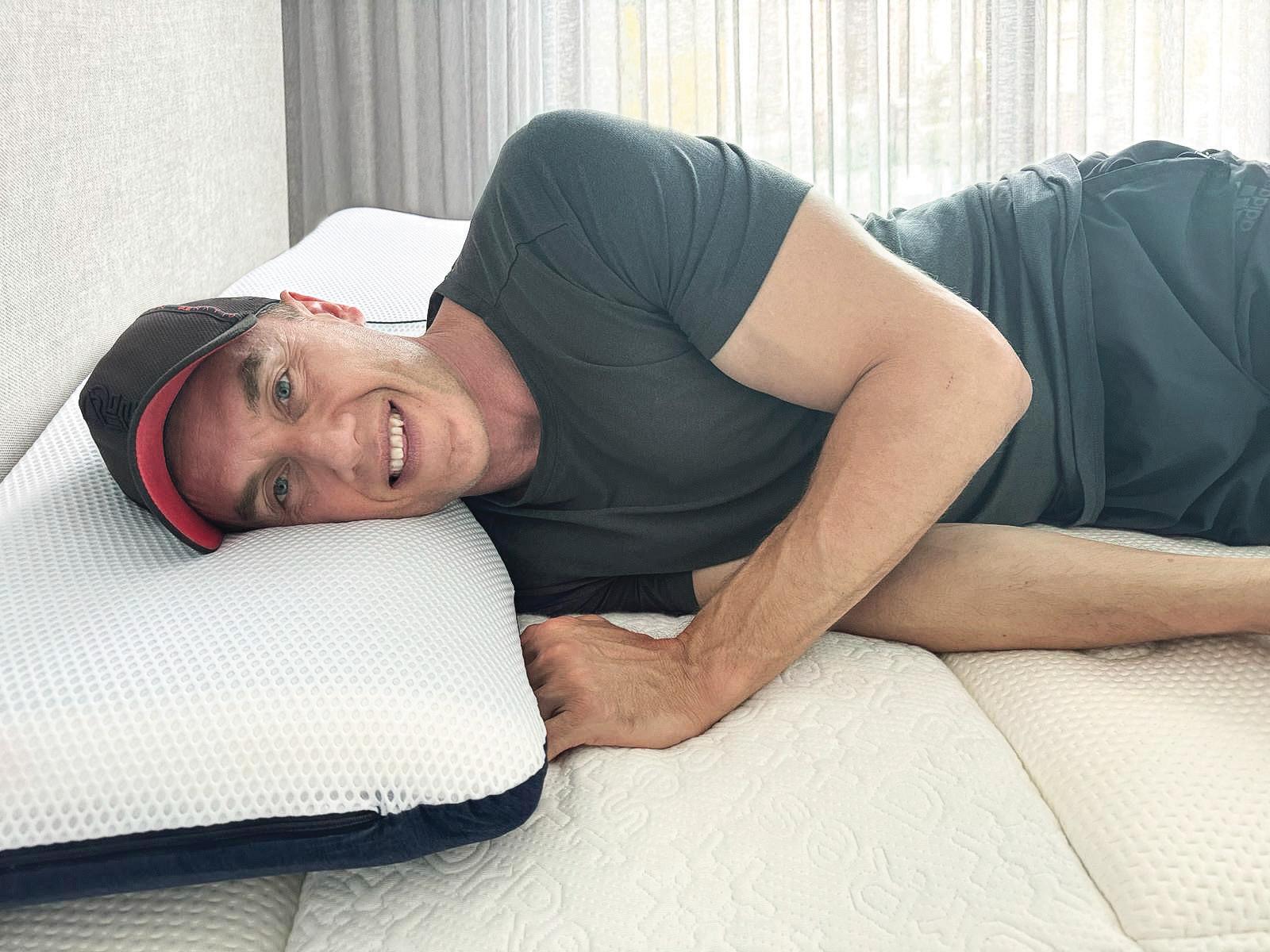
fascinating in that it helped absorb the pressure of my shoulder while still providing support around it.
Also, with my sore hip, it was interesting how supportive the DrRest mattress was in that region.
Then experiencing my spine being straight as I lay on my side was a genuinely relaxing feeling.
Being designed by Australian health experts who have done the research gave it further integrity and appeal for me.
How different have you found the DrRest Technogel adjustable pillow from your previous pillow?
my opinion, sleep is actually recovery time, so your mattress and pillow are really important for rehab and recovery from any injury. With DrRest, I don't even have to worry which side I'm sleeping on now...it's no longer a problem. I can confidently attribute the DrRest mattress and Technogel pillow as key components to my shoulder rehab and recovery in a big way.
I don’t say this lightly or as a throw-away comment, but I would never get another pillow… I am totally in love with it. It’s definitely more comfortable and I don’t wake up with a stiff neck. In fact, my body feels refreshed.
Extensively researched by a team of Australian health professionals, the DrRest sleep system has a patented design and configuration that facilitates musculoskeletal support and enhances rest and relaxation for individuals of all body types.
The integration of a TechnogelⓇ shoulder zone is unmatched in supporting spinal balance & alignment and is the cornerstone of quality sleep and recovery with the DrRest sleep system. Visit drrest.com.au or email info@drrest.com.au to learn more.
Osteopath Catherine McDuling tells Osteo Life about her experience working as a rural osteopath in Dubbo, NSW – including what to expect, the best parts, the most challenging parts, why she loves it, and why she’d encourage you to do it too.
Working in the country was never my plan, but I am so glad I took the leap as a new graduate osteopath to move from my hometown of Melbourne to work in Shepparton in regional Victoria. This move was invaluable in helping me prepare for my latest adventure.
We were told at university that working in the country was a great way to become busy quickly and gain exposure to a range of challenging patient presentations, and this has certainly been my experience of working in rural and regional Australia.
In Shepparton, I treated everyone from three-week-old babies to 90-year-olds. I saw lawyers, farmers, triathletes and new migrants who spoke little English. I was met with complex patient presentations requiring thorough research to determine the best treatment approach.
And now in a roundabout way, after three interstate moves, I find myself back in the country – working in Dubbo, Central West NSW. Our young family has moved here for my husband’s studies at the University of Sydney School of Rural Health – a new medical program designed to draw future medical practitioners to the region and foster careers in rural healthcare. I’ve only ever worked in rural and regional locations, and this is where my husband and I want to provide our services – in the areas of greatest healthcare need.
I want to encourage other osteopaths to make the move to rural practice because I see so much need and scope for our profession in rural and regional Australia. We can offer these communities so much with our holistic approach to healthcare and unique skillset. But I want to be honest in painting the whole picture of rural practice – not only the good, but also the challenging aspects.
Your experience of moving to a rural location will differ vastly depending on your personal and career circumstances. Moving to Shepparton on my own as a new graduate employee was quite a different experience to moving to Dubbo as a business owner with a partner, a baby, a dog and my husband’s parents. But there were certain things in common with both experiences:
People are generally friendlier. Many people have also recently moved to the region for work or study, so you can often find some common ground with strangers. Having this common ground makes it easier to make new friends. You will start to see your patients everywhere. Be prepared to run into them at any moment!
Your reputation will spread quickly, so make sure it’s good! It goes without saying, but treat everyone with the utmost care and respect, and always honour your patient’s privacy. You will probably get busy very quickly. I wasn’t prepared for this, and it has left me a little burnt out. Have an idea about how you will create a work-life balance.
You are likely to see a lot of complex, chronic health problems. This is due to the lack of access to healthcare services. Patients often travel long distances for specialist medical care. In Dubbo there is also a severe GP shortage.
In rural and regional communities, fostering personal and professional relationships is key. You will get out what you put in, so take the time to get to know people personally, as well as local businesses and organisations.

Catherine McDuling is an osteopath and ASCA-qualified strength and conditioning coach working in solo practice in Dubbo, NSW. She is the only osteopath in a town of 45,000 people. Patients travel from as far as Lightning Ridge on the NSW/ Queensland border because she is their closest osteopath.
Get involved in the community. Join clubs and groups to meet like-minded people and make new friends. You may also find opportunities to promote your services and develop partnerships with local clubs and organisations. Consider sponsoring sports teams. Sport is the lifeblood of regional and rural Australia. If you don’t have the funds to be a sponsor, think of another way to form a mutually beneficial partnership. Develop business-to-business relationships. A business relationship could be as simple as regularly buying coffee from the same cafe and chatting with the barista about what you do. It could also involve developing a referral relationship with other allied health and medical practitioners, with regular communication regarding mutual clients.
Work/life balance. My commute is a 15-minute drive to the opposite side of town. Traffic is almost nonexistent. Getting anywhere in town generally takes 10-15 minutes, so you have more time in your day to do the things you love.
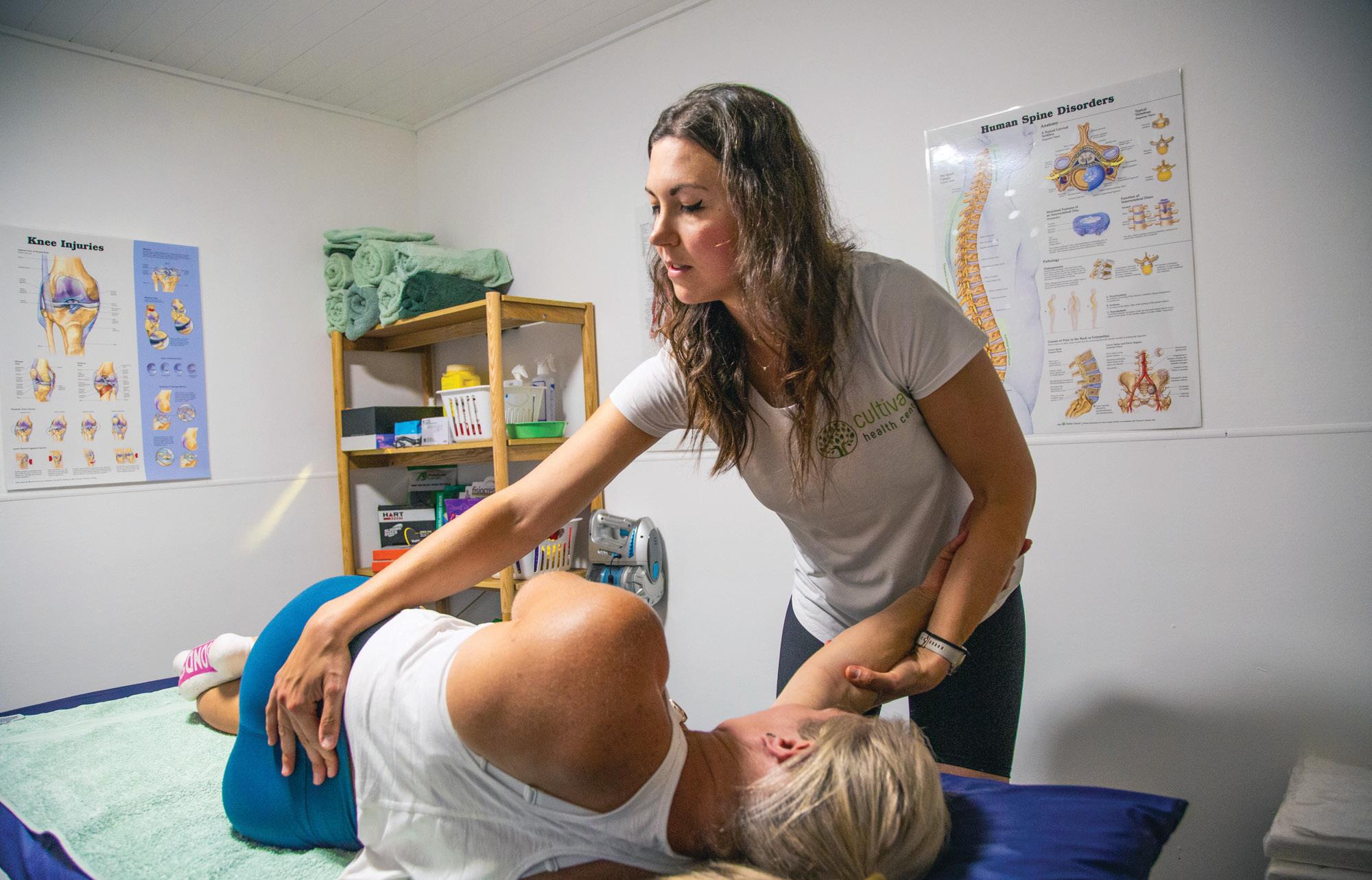
Being the only osteopath within a large radius means you don’t have to worry much about competition!
If you do your job well, you can almost guarantee your books will fill quickly. There is no need to spend lots of money on SEO, advertising and marketing to get that slight edge over the competition – unless you want to! Enjoy the green space and sports facilities. Plenty of sports fields and parks allow you to enjoy the outdoors, whether on your own or with friends and family.
Community connection. Everyone seems to know everyone! Some might see this as a disadvantage, but I love it. Housing affordability. It’s much cheaper to buy a house, and you can have a larger block. The rental market is competitive but much cheaper than the major cities. Funding opportunities. If you are moving to rural NSW, you may be eligible for relocation funding through the NSW Rural Doctors Network. You can also apply through this network for scholarships or bursaries to complete further study in areas of need, such as women’s and children’s health.
Moving away from family and friends. This was by far the hardest part for me. It continues to tug at my heartstrings. There are no direct flights to Melbourne and it’s a 10-hour drive without stops.
The cost of moving. Not only the cost of moving house, but also moving my business and having to start again with a new clientele. Moving from Geelong to Dubbo involved significant costs due to the distance and the time of year we were required to move. However, this will vary depending on your situation. Lack of services. As I’ve already mentioned, health services are in high demand. Getting an appointment with a GP can be a struggle, and specialist waiting times can be lengthy or require travelling long distances.
For me, the benefits of working rurally far outweigh the negatives. If you haven’t guessed by this point, I love what I do, and where I work. People are appreciative of our work – in fact,
they are so supportive of any health or medical professional who moves to the area. I have lost count of the times people have said to me ‘We’re so glad you’re here,’ or ‘I’ve been waiting for an osteopath to come to Dubbo.’
I’ve enjoyed getting involved in local sports clubs and finding plenty of familyfriendly activities to do with my young family. We’ve found our people through the groups that we’re part of and we’ve been welcomed with open arms.
Regional and rural Australia desperately needs more health practitioners, especially osteopaths. Some clients travel 400km to see me because I am their closest osteopath. If you’re a new career osteopath, working in the country is a great way to gain exposure to a wide range of patient presentations and to build a caseload rapidly. Within two months of working in Dubbo, I was booked out two weeks in advance, with a waiting list. I can’t service a town of 45,000 people alone, not to mention the surrounding regions. I’m now actively recruiting, so if you are interested, please feel free to contact me.
from sunny Perth!
We’re having a fabulous time over here and want to share our exciting news with you! In recent years, a collective of WA clinic owners have made it their mission to make Perth the best place for early career osteopaths to jump start their career. We’ve attracted adventurous, enthusiastic professionals eager to learn and engage with the opportunities Perth offers. In the past three years, 18 osteopaths have moved to WA, bringing fresh energy and becoming an integral part of our community. It has been wonderful to see them connect and share their experiences of moving interstate after graduation.
Program, so you always know what’s happening and who’s presenting next.
Every clinic featured on our website hosts a monthly seminar for early career osteopaths in their first five years postgraduation. This program offers at least 12 hours of free, quality CPD annually, providing a great opportunity for new clinicians to connect, learn and share experiences. Topics covered include practice efficiency, honing palpation skills, advanced techniques, and the physiology and osteopathic influence of the menstrual cycle. It’s great fun and highly valued by participants.
Our website is your go-to resource. It details participating clinics in Perth, their locations, ethos, clientele and job vacancies. All contact details are listed, so it’s easy to find a clinic that resonates with you.
Our website and Instagram showcase stunning WA scenery. Recently, we posted an emu swimming in crystal-clear waters on the southern WA coast. Our platforms also provide details on our State Mentorship
Phenomenal community: diverse clinical interests and experiences, with generous knowledge sharing.
In May 2024, Edith Cowan University announced it would be the first to offer an osteopathy course in Western Australia. Spearheaded by Osteopathy Australia and its New Course Committee, this initiative will expand access to osteopathy for Western Australians and create pathways for osteopaths to contribute to healthcare outside of private practice.
If the structure and support aren’t enough, here are more reasons to move to WA: 21,000 km of pristine, world-class beaches; 300 days of sunshine annually; Easy commutes (average 20 mins); Outdoors lifestyle;
Patients prefer not to be seen after 7pm; Busy clinics: one osteopath per 39,000 West Australians (compared to one per 3,000 Victorians);
CPD opportunities: reduced costs for accommodation, flights and time off work due to well-attended local courses; Explore More www.osteopathyinwa.com
We won’t have any new graduates with us from ECU until 2030 at the earliest. If you want to come and join our dynamic community and busy clinics, and learn in a supportive environment, we would love to hear from you!
We should note that moving interstate to any of the smaller states is going to be beneficial to your career! Even if just for a few years, why not see more of Australia and have an adventure?
For more information, get in touch with us today!
www.osteopathyinwa.com osteopathyinwa
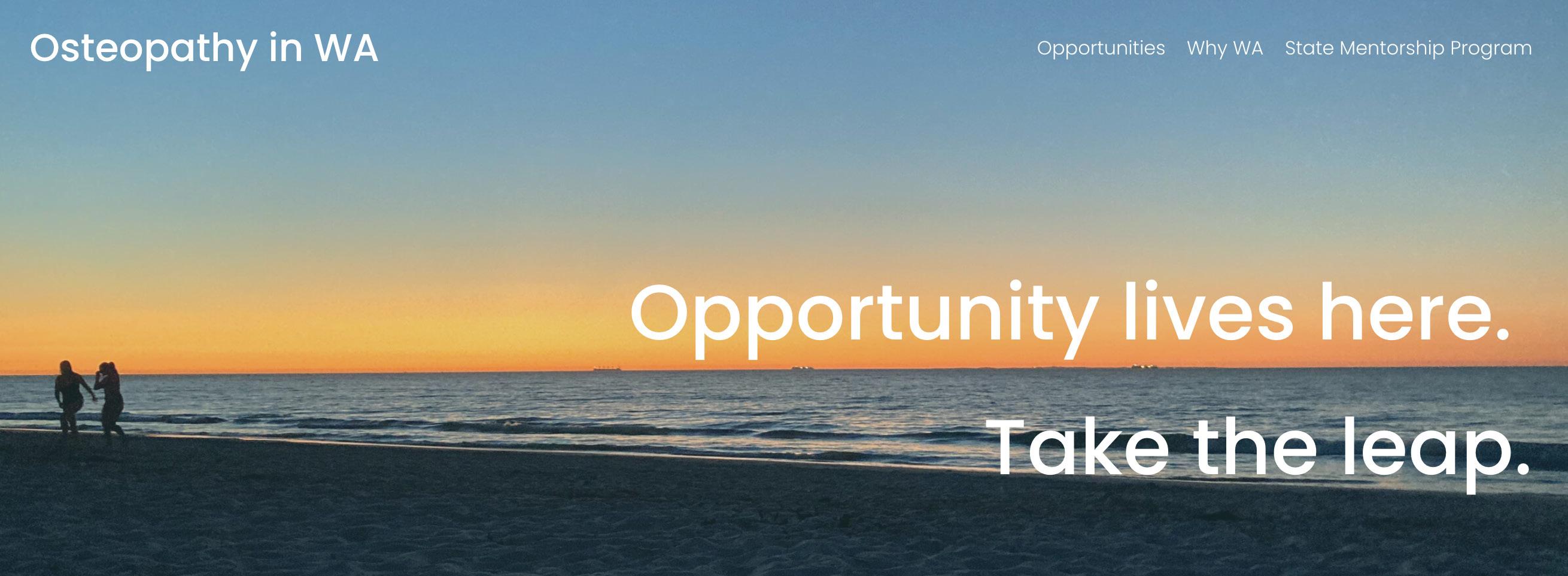
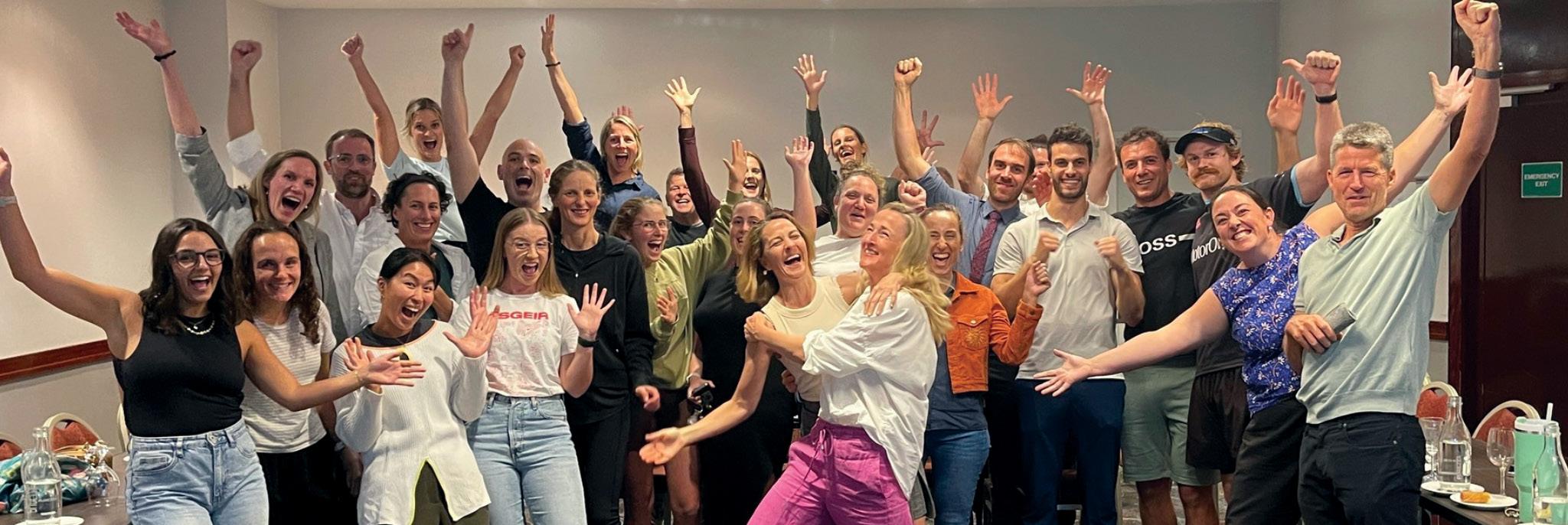
Hi there! My name is Madison Pappa, and I am an RMIT graduate from the class of 2021. I was born and raised in Melbourne, Victoria, and two years ago, I decided to move to Perth, Western Australia. This is my experience of the first few years of clinical practice and how moving interstate has shaped my career so far.
The COVID years were challenging for everyone, but they were especially difficult for those of us in our final years of study. The last two years of an osteopathic degree are all about refining skills, gaining confidence and beginning to treat the general population under the guidance of clinicians. Unfortunately, this was not the case for us. The question then became: how do we make up for that missed experience, especially when the Melbourne allied health scene is so competitive for experienced osteopaths? How do I earn enough to fund osteopathic courses to grow and refine my knowledge? How do I know I haven’t wasted my money on a course that is aimed at more experienced osteopaths? How do I ensure my workplace will provide the promised personal development tutorials? All these questions were answered by moving to Perth and joining its state mentoring program.
Let’s discuss the benefits of moving to Perth or another area where the need for osteopaths can make your work life more enjoyable. Moving to areas with a
high demand for osteopaths and allied health professionals increases your patient numbers. For recent graduates, it’s crucial to build a solid foundation of knowledge, and you learn and retain much more on the job. The best thing new grads can do is to get hands-on experience with patients, which is much easier in a clinic or area with an overflow of patients. In Western Australia, there are fewer than 80 osteopaths, so there is definitely a demand. What kind of lifestyle do you want outside of work? My main motivation for moving to Perth was the relaxed beach lifestyle Western Australia is renowned for, and Perth is one of the sunniest places in the country. The first few years in private practice are incredibly challenging. It’s a fine line between seeing enough patients to feel financially secure but not so many that you feel constantly burnt out. Personally, I love finishing off a hard day by heading down to the beach to complete my clinical notes and watch the sunset – a perfect way to reset before heading home. In response to the shortage of osteopaths in Perth, clinic owners, who are typically competitive, came together to form the state mentoring program to encourage new graduates to make the move. As part of this program, we have 12 hours of personal development run by clinic owners and senior osteopaths to mentor younger osteopaths and
“Over time, these friendships become a chosen family that you rely on and have deep connections with”
foster a sense of community. The community aspect of this program is truly unparalleled. Recently, a group of us new-to-Perth osteopaths went camping in Kalbarri for Easter break.
Now, let’s address some common concerns people have when considering a move.
The cost of moving was a significant upfront expense, especially for a new graduate with Ahpra and Osteopathy Australia memberships to pay. However, speak to your employer about this – they will often help mitigate the financial risks.
Continuing Professional Development (CPD) courses are often held in the eastern states. While this is true, we have been fortunate to have some great courses come to WA. The more osteopaths and demand here, the more courses will come. I often buy courses in Melbourne and take the opportunity to combine them with a holiday.
Perth is indeed far from everything. It’s one of the most isolated capital cities in the world, but it’s only a four-hour flight to Melbourne. There are regular flights, and costs are decreasing due to demand. Being further away from family and friends can be a benefit. It encourages you to lay down roots and become more self-reliant, as you can’t just fly back for every event.
Making friends as an adult can be challenging, but there are many amazing communities in Perth, largely due to the weather. Many people move to WA due to visa requirements, so there are plenty of opportunities to make friends. In our osteopathy community, most of us have come from regional WA or Melbourne, so we understand the challenges of living far away. Over time, these friendships become a chosen family that you rely on and have deep connections with.
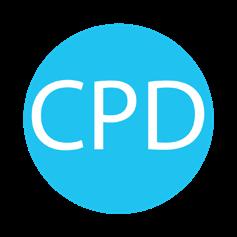
Guild Insurance’s analysis of osteopathy-related complaints reveals key risk management tips, aiming to reduce incidences through improved communication, adherence to guidelines, thorough assessments, and informed consent, enhancing overall patient satisfaction.
Guild Insurance spends a great deal of time analysing claims and/or complaints relating to osteopathy treatment. This involves complaints made directly to the osteopath or osteopathy practice as well as complaints to a regulatory body such as Ahpra. This analysis helps Guild better understand a number of key details such as:
What the complaint or allegation is about; What the factors are which may not be mentioned in the complaint yet have contributed to the incident and therefore the complaint occurring; What could have been done differently to possibly avoid the complaint from occurring.
This information is then used to develop what Guild calls risk messages for osteopathy. These are pieces of information which will guide the profession in relation to risk management tips and strategies to reduce the likelihood of complaints being received. It’s important to understand that risk management can’t guarantee a poor outcome or complaint won’t ever occur. However, by adhering to the following messages, osteopaths are taking positive steps to reduce the likelihood.
1
Ensure you make communication a key feature of your work Guild’s claims analysis suggests that poor communication is a feature in almost all treatment-related complaints. While patients rarely complain about poor communication, although this does happen, when an incident is investigated poor communication is quite often a factor. Osteopaths must continually focus on their communication
with patients, patient’s families where relevant, colleagues and other health professionals. Remember to explain what you do and why during your treatment. Good clinical skills alone aren’t enough to make someone a safe and effective osteopath.
2
Know and adhere to all Ahpra requirements
As a health professional registered with Ahpra, it’s every osteopath’s responsibility to make themself aware of what’s required. This means making the time to seek out and read the numerous codes and guidelines found on the Ahpra website (ahpra.gov.au). Some of these documents detail what’s considered best practice. However, some information actually refers to the law. Not knowing this information is no excuse for not adhering to it.
3
Adhere to the advertising guidelines
Ahpra’s expectations regarding advertising are explained in the Guidelines for Advertising Regulated Health Services document which can be found on the Ahpra website. There are numerous complaints continually being lodged with Ahpra alleging health professionals are breaching these guidelines. Osteopaths need to be aware these guidelines specify what’s required under the National Law and non-compliance is a criminal offence for which hefty fines can be imposed.
4
Ensure there has been an adequate assessment process prior to treatment
Assessing before treatment seems like an obvious suggestion. However, it’s not uncommon to see claims where the assessment process hasn’t been thorough enough leading to treatment which is inappropriate or ineffective. The assessment process should not be rushed. Details of the assessment and findings are to be recorded in the clinical record and osteopaths must be sure they don’t make assumptions or fall into routines. Remember, poor assessment usually leads to poorly selected treatment.
5
Manage patient expectations
It’s important that patients have realistic expectations regarding their likely treatment outcomes. Unrealistic expectations are rarely met. Unmet expectations will often lead to patients being dissatisfied with treatment and more likely to complain. It’s the responsibility of the osteopath to be sure a patient’s expectations are realistic before treatment begins. Osteopaths must remember that in most cases patients won’t have the clinical knowledge and understanding they have. Osteopaths should never assume a patient understands their treatment or what is likely to happen post-treatment; they must have a conversation to ensure this understanding.
“It’s important that patients have realistic expectations regarding their likely treatment outcomes. Unrealistic expectations are rarely met”
“It’s important to understand that risk management can’t guarantee a poor outcome or complaint won’t ever occur. However, by adhering to the following messages, osteopaths are taking positive steps to reduce the likelihood”
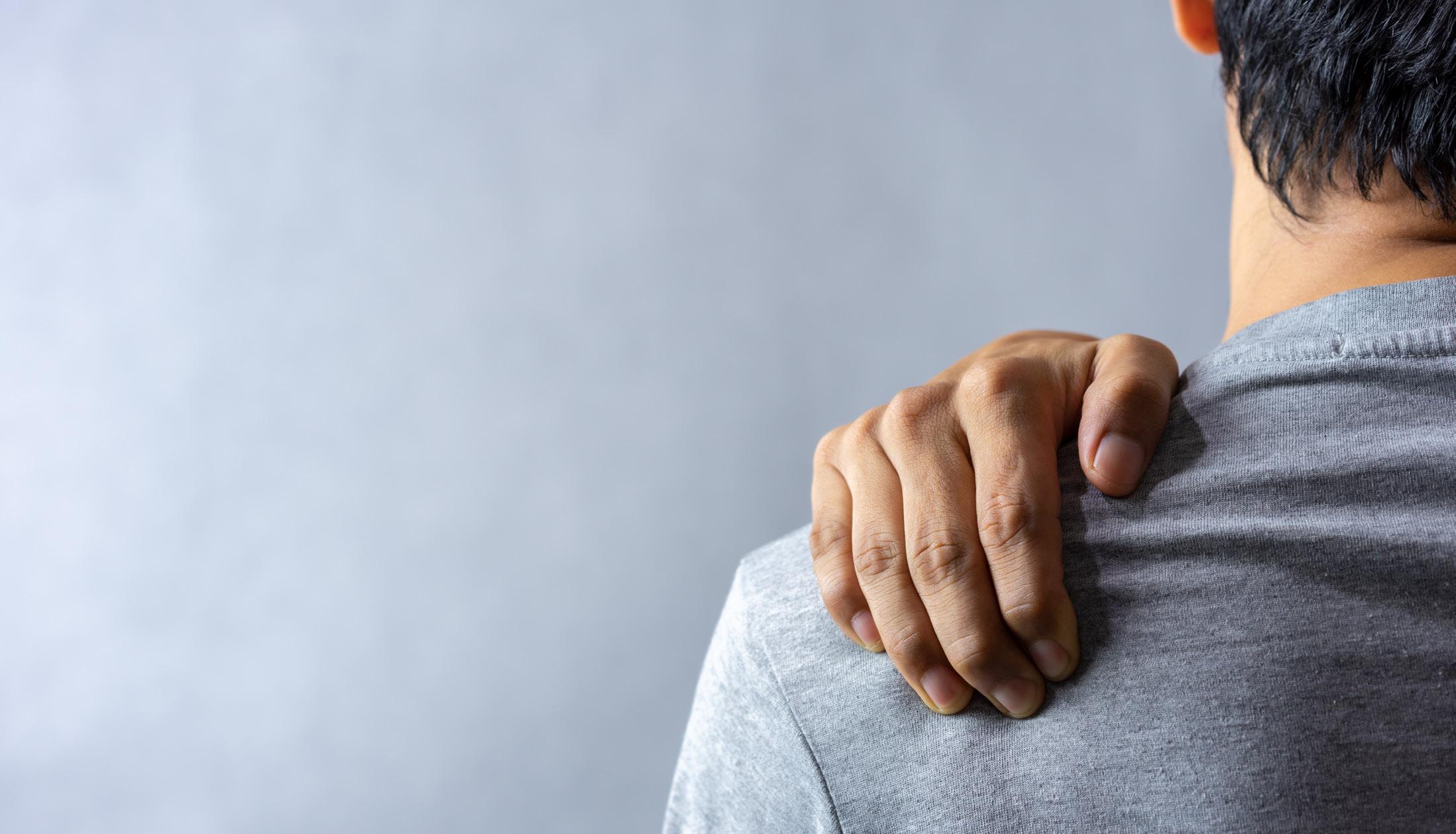
6
Be sure patients have given their informed consent to treatment
Patients must be given the opportunity to provide their informed consent to treatment before being treated. Informed consent requires a conversation between the treating osteopath and patient about recommended and alternate treatment options as well as the benefits and risks for each of those options. Informed consent should include informed financial consent, which is a discussion about the expected costs of treatment. Details about this consent discussion should be recorded in the clinical record. Signing a generic form at reception prior to the first treatment is not informed consent.
7
Be mindful of treatment around sensitive areas
Guild Insurance sees numerous claims each year where a patient has accused an osteopath of touching them inappropriately during treatment. In the majority of these cases, the treatment has been appropriate and justified. However, the osteopath’s communication about the treatment has been lacking leaving the patient confused about where and how they’ve been treated and why. Never make an assumption
about a patient’s understanding or comfort level. Be sure they understand the treatment and the reason for it before you proceed, particularly when treating around sensitive areas. It’s the osteopath’s responsibility to explain the treatment in simple, non-clinical language so the patient understands. And be sure to always use appropriate coverings, such as towels, to ensure patient modesty is protected.
8 Refer to another practitioner when required
Osteopathy plays a key role in the Australian healthcare system; however it’s important to understand that other health professionals do too. There will be occasions when a patient presents for treatment, yet the osteopath won’t be the most suitable person to provide that treatment. Osteopaths must recognise those occasions and be sure they refer those patients to the appropriate professional. Sometimes the most appropriate treatment an osteopath can provide is no treatment at all.
9
Don’t allow yourself to be coerced into doing things against your better judgement There will be occasions when an osteopath is being asked to do
something they don’t believe is in the best interests of the patient. At times they’ll find they’re actually being coerced or forced into something even when they’ve advised against it. This may be when a patient is asking for a particular type of treatment which the osteopath doesn’t believe is clinically justified. Or when an osteopath has decided against treating a patient, yet the patient insists on some form of treatment. Osteopaths need to be sure they aren’t convinced to do something they don’t believe is appropriate. They must remember that they’re always responsible for their clinical decisions and they need to be sure they can justify those decisions.
10 Maintain adequate clinical records
Clinical records are an osteopath’s history and evidence of what took place, and they serve numerous purposes. They assist with ongoing clinical care, as no osteopath can remember how they’ve treated every patient in every consultation. They also assist as evidence if an osteopath’s treatment is ever questioned by a patient, regulator or private health insurer. And finally, they’re necessary for meeting the expectations of the Osteopathy Board of Australia.
Rehabilitating Olympic athletes involves tailored programs, advanced technologies and multidisciplinary collaboration to ensure full recovery and optimal performance. This article explores the essential strategies for success in this complex process.
Rehabilitating Olympic athletes presents a dynamic and multifaceted process, encompassing a variety of challenges and innovative solutions specifically tailored to the unique demands of preparing for the world’s most prestigious sporting event. This article delves into the rehabilitation challenges faced by Olympic athletes and explores the diverse strategies osteopaths can implement to help them overcome these hurdles. From the initial injury diagnosis to the return to peak performance, every step of the rehabilitation journey must be thoroughly planned when preparing our athletes for representing the green and gold.
Olympic sports encompass various disciplines, each with physical demands, injury risks and performance expectations. From high-impact sports like gymnastics and athletics to endurance-based disciplines such as cycling and swimming, the diversity of Olympic sports presents unique challenges when it comes to rehabilitation. Injuries common to Olympic sports can range from acute sprains and strains to chronic overuse conditions, fractures and concussions, among others. The prevention and management of these injuries often involve an interaction of intrinsic, extrinsic and mechanical factors,1 adding complexity to the injury. Therefore, rehabilitating Olympic athletes should consider not only the physical aspects of the injury, but also the athlete’s psychological, nutritional and biomechanical aspects.
Rehabilitating Olympic athletes returning from injury presents its own unique set of challenges. Here are some of the most common faced by athletes and their rehabilitation teams during this process:
1. Time constraints and competition schedules Olympic athletes operate within stringent timelines, with competition schedules dictating the urgency of the rehabilitation process. Injuries occurring close to major events put immense pressure on athletes and their rehabilitation teams to accelerate recovery without compromising long-term outcomes. Every day counts in the rehabilitation journey of an Olympic athlete, highlighting the importance of maximising each session’s effectiveness, athlete adherence and minimising setbacks that could impede progress. Balancing the need for a rapid return to competition while reducing the risk of reinjury poses a significant challenge when rehabilitating under a time constraint.
2. Multidisciplinary collaboration
The multidimensional nature of Olympic sports requires collaboration among various stakeholders, including sports medicine specialists, manual therapists, strength and conditioning coaches, nutritionists, sports psychologists and coaches. Effective communication and coordination among these professionals is paramount.
3. Risk of reinjury and overtraining
Athletes striving to regain peak performance may face the temptation to push too hard, too soon, potentially leading to reinjury or overtraining. Data


Jason Izydorczyk graduated from Victoria University with a BSC (Clinical Sciences) and a Master’s in Health Sciences (Osteopathy) in 2018. During his studies he competed nationally and internationally as a rower and undertook internships at both the British School of Osteopathy, London and SMRC Hospital, India. During his years of practice, he broadened his osteopathic skills by undertaking seminars in dry needling, tendon rehabilitation, strength and conditioning, and mental health. He currently practises out of a private practice in Bayside and mentors elite junior rowers.
on the relationship between load and risk of injury highlights that the rate of load application is more influential than the overall volume of load.2 Managing athletes’ eagerness to return to full activity while ensuring gradual and small increments in loading is crucial to minimise the risk of setbacks.
4. Psychological stresses and performance anxiety
The pressure to perform at the highest level, especially in Olympic competition can contribute to psychological stress, anxiety, and fear of failure among athletes. Scientific research currently suggests mental health disorders affect up to 35% of elite athletes at some stage of their careers.3 Addressing mental health aspects, building resilience and providing psychological support are integral components of successful rehabilitation in Olympic sports.
5. Sports specific demands and biomechanical challenges
Each Olympic sport imposes distinct physical demands, movement patterns and technical skills that require specific rehabilitation approaches. Understanding these demands and tailoring rehabilitation exercises and interventions to replicate sport-specific movements and conditions are essential for functional recovery and performance optimisation.
Innovative solutions and strategies play a fundamental role in the progression and success of rehabilitating Olympic athletes. Several strategies that can be adopted by the rehabilitation team are:
1. Specifically tailored rehabilitation programs
Creating a specific, personalised rehabilitation program tailored to the individual athlete’s injuries, functional deficits, sports-specific demands and performance goals is essential to effectively rehabilitate Olympic athletes. These programs often integrate a combination of strength training, neuromuscular conditioning, flexibility and mobility exercises and sports-specific drills, all while adopting progressive loading protocols. Thorough consideration of the individual athlete throughout the rehabilitation process improves all aspects of recovery.
2. Advanced technology and biomechanical analysis
Integration of advanced technology such as motion capture systems, wearable sensors and virtual reality simulations provides valuable insight into athlete movement patterns and performance metrics. Using this technology will allow the rehabilitation team to biomechanically analyse athletes more accurately, helping them guide rehabilitation programs aimed at correcting movement deficiencies, optimising mechanics and preventing future injuries.
3. Interdisciplinary collaboration and communication
A cohesive interdisciplinary approach involving sports medicine professionals, coaches and support staff fosters effective collaboration and communication throughout the rehabilitation process. Regular meetings, shared decision-making
and transparent communication channels help ensure a coordinated effort, giving athletes the reassurance and support they need when recovering from an injury.
4. Progressive rehabilitation protocols and stages
Adopting and outlining step-bystep progressions during the various rehabilitation stages emphasises a systemic and evidence-based approach to ensuring athletes’ readiness while minimising risk of injury. Each stage should incorporate objective criteria for advancement and continuously be referred upon throughout the rehabilitation process. This data serves as a common language among healthcare professionals and athletes, ensuring better understanding and communication from all parties.
5. Psychological support and mental training
Sports psychological measures play an important role during injury rehabilitation. Psychological interventions such as stress management techniques, breathing exercises, mindfulness, motor imagery and cognitive restructuring have been shown to be highly effective in rehabilitating athletes.4 Educating and encouraging athletes to seek psychological support is something the rehabilitation team should always consider.
6. Nutritional optimisation and hydration strategies
Nutrition and hydration play a pivotal role in recovery and performance. Working with sports dietitians to optimise athletes’ nutrition intake, hydration status and dietary strategies can help combat inflammation, improve energy levels and promote tissue healing, among many other benefits.5
AND INNOVATIONS
Sport is constantly evolving and changing. With the rapid evolution of technology and scientific advances, future limits in athletic performance will likely be determined less and less by the innate physiology of the athlete, and more by the tools at their disposal.6 Here are some future directions and innovations that are currently being explored within sports rehabilitation.
1. Data driven rehabilitation and AI With a significant reliance on data recording devices in sports, the use of complex
models for data analysis can be an effective tool for informing athletes and their teams about injury risk and prevention.7 AI, machine learning algorithms and predictive modelling tools can dig through large pools of data and find the bits that can help teams make better choices before the problems show up. These tools are already being utilised in sports, with various studies highlighting their effectiveness in optimising training loads, predicting performance outcomes and personalising rehabilitation strategies based on the individual athlete and data obtained.7,8,9
2. Tele-rehabilitation and remote monitoring
Telehealth platforms and remote monitoring have become integral resources in providing further accessibility to healthcare.10,11 Expanding these tools to coordinate with wearable sensors, virtual reality devices and mobile apps will allow rehabilitation teams to frequently and remotely track progress and provide real-time feedback to Olympic athletes.
3. Virtual reality training environments
Inherent to the nature of virtual reality is the potential to design and manipulate freely an almost infinite number of procedures for training athletes.12 This helps to improve athlete engagement, motor learning, skill acquisition and mental readiness to certain performance situations. It also enables Olympic athletes to learn remotely at any time and place of their own choosing, improving accessibility to rehabilitation environments.
Rehabilitating Olympic athletes requires a comprehensive, integrative approach that addresses the physical, psychological and biomechanical components of the athlete and their respective sport. Innovative solutions, interdisciplinary collaboration, personalised interventions and a focus on holistic wellbeing is essential when preparing for the challenges faced along the rehabilitation journey. By leveraging advancements in technology, sports science and evidence-based practices, rehabilitation teams can navigate these challenges effectively, improving recovery trajectories and empowering our athletes to excel on the Olympic stage and beyond.
References on page 30

Not all athletes who rupture their anterior cruciate ligament (ACL) opt to undergo surgical reconstruction, but in select people, with the appropriate management, they can achieve a successful return to their sport, or even a complete healing of the ACL.1 Osteopaths can play a key role in managing such patients and in contributing to their decision-making. This article is an update of the same article published in the summer 2021/2022 issue of Osteo Life, which summarises our experience with, and some of the current literature describing, the potential options for non-surgical management.
Anterior cruciate ligament (ACL) ruptures and their clinical sequelae place a major burden on health systems around the world.2,3 In Australia, the estimated cost to the hospital system of ACL reconstruction (ACLRe) was $142 million in 2014/15.2 The burden is compounded by rising rates of ACL rupture (ACLRu) and subsequent ACLRe.3 For example, in England, the rate of ACLRe rose 12-fold between 1997 and 2017,4 while in Australia, it rose by 43% annually between 2000 and 2015; more alarmingly, ACLRe rose by 74% in those under 25 years of age over the same period.2 There is clearly a need for improved prevention and management strategies in this area.5
Surgical reconstruction is the most common management approach for athletes who sustain an ACLRu, 5 underpinned by the widespread belief that the ACL has limited self-healing capacity, despite research demonstrating the contrary.6 Furthermore, despite the high rates of ACLRe, not all athletes achieve a
successful return to play (RTP), with only 65% of non-elite athletes who opt for an ACLRe returning to their preinjury level of sport.7,8 Additionally, 30% of athletes who RTP following ACLRe sustain a second ACL injury within two years.9
Alternative ACLRu management options have been considered for some time, including increased attention to nonsurgical management.10 There is evidence that suggests some athletes will be able to cope with the RTP demands when opting for non-surgical management of ACLRu.11,12,13,14 Not only is the non-surgical management option attractive from the perspective of avoiding the costs and other risks associated with surgery, but it also offers a way of potentially shortening RTP times.15 That said, this option is not for all athletes, and a rigorous screening process is required before pursuing nonsurgical management of ACLRu.
Recently, researchers performed a secondary analysis of the KANON trial, which was originally a randomised control trial (RCT) investigating the differences between rehabilitation-alone (no-surgery), delayed ACLRe and early ACLRe in ACLRu patients.1 Amazingly, they found
“Some athletes will be able to cope with the RTP demands when opting for non-surgical management of ACLRu”
Louise Bibby is a titled Advanced Sports osteopath whose interests include sport performance, athlete rehabilitation, rural practice and leadership. She is the founder and director of a private practice with several locations across the Mallee in Northern Victoria, the founder of Outreach Osteo as well as Osteo Sports Network. She has a particular focus on advanced and accelerated rehabilitative protocols for athletes returning to sport, dedicating time to youth athlete development, athlete preparation, sport skill development and lower limb injury risk reduction for track, field and court sport athletes.
NICHOLAS TRIPODI
Nicholas Tripodi (PhD) is a Senior Lecturer and Research Fellow at Victoria University, where he works to contribute to the osteopathic profession through the inception and implementation of novel translational research. As an osteopath in clinical practice, he has a particular interest in the treatment, rehabilitation and biomechanical analysis of teamsport and endurance athletes.

that 56% of the participants in the rehabilitation-alone group had a healed ACL at two years follow up, with this subgroup also reporting more favourable Knee Injury and Osteoarthritis Outcome Scores (KOOS) when compared to the non-healed or reconstruction groups.1
With the research clearly demonstrating the ACL has self-healing capacity, a group of researchers based in Australia conceived the innovative ‘Cross Bracing Protocol.’ In short, this protocol involves fitting the knee with a brace locked at 90 degrees and, over a 12-week period, gradually increasing the knee flexion angle and exercise rehabilitation difficulty until the brace is removed at the end of this period.6 The theory behind this was that at 90 degrees, the two parts of the torn ACL are moved closer together and stabilised, and therefore will have a better chance at joining, much like fitting a cast or brace for a bony fracture. From their initial pragmatic work, it was shown that 72 out of 80 (90%) participants have signs of ACL healing on MRI at the three-month mark.6 It is important to note that participants in this study did not have any significant concomitant knee injuries (i.e. unstable meniscus tears), and that it requires close supervision of a multidisciplinary
medical team given the high chance of blood clots in the early stages. This research is very exciting, with further RCTs investigating the protocol underway at the time of writing. Given that the results of these future works are still pending, the remainder of this article will discuss the management of non-surgical ACLRu when not using a Cross Brace or any other intervention beyond exercise rehabilitation.
There are three well-accepted classifications that the appropriately trained clinician can apply to the ACLdeficient patient in practice:16,17,18
Coper. A person who can fully return to their previous level of sport/activity without ACLRe. Adapter. A person who can function without ACLRe, but has to modify/ change their previous activity level. Non-coper. A person in whom non-surgical management of their ACLRu fails and who requires ACLRe to return to their activity.
So how are these patients identified? Moksnes et al. (2008) have developed screening criteria to help classify potential copers (Table 1). Patients should only undergo this screening following initial management of
Timed six-metre hop test
Knee outcome survey activities of daily living scale (KOS-ADLS)
Global rating of knee function assessed by a visual analogue scale
Number of giving-way episodes since the injury
Based on Moksnes et al, 2008
Within 80% of the non-injured side
≥80%
≥60
No more than 1
“Each athlete’s circumstances are unique and need considered planning and input from their medical team”
their ACLRu (see box below) and after they have minimal to no joint effusion, a normal walking gait and can hop on the injured side without pain.17 It is important to remember that the outcome of screening is not fixed after the initial evaluation, as patients can potentially move from one classification to another depending on the progress of their recovery.
When working with ACLRu athletes, an osteopath will almost always be working in a team care setting. A team care approach, with constant dialogue between all the health professionals involved, ensures that as much information as possible is collected to help guide a patient’s decision about their preferred treatment option. Each athlete’s circumstances are unique and need considered planning and input from their medical team to successfully map their return to sport (see box on page 29). An osteopath can play a key role in the team care environment and patient decision-making process. In the first instance, their role is to take a thorough history, including the patient’s recollection of the incident and the injury ‘moment in time’. There will be a report of symptoms at the time of injury, and these can often
change in the following hours and days. Other important considerations when determining the best management approach include the patient’s age, occupation, health status, lifestyle factors and previous or concomitant injuries, as well as their sporting goals and ambitions. This information, combined with a thorough assessment including both functional screening (if possible without pain and apprehension) and isolated knee orthopaedic testing, will help to determine the mechanism of injury, urgency of most appropriate referral if more substantial trauma is suspected (meniscus derangement, multiple ligament ruptures, fracture), and the best approach to education, reassurance and support. It is important to make the patient aware of the risks involved with both surgical and non-surgical management of ACLRu to help them come to an informed decision. In particular, the longer-term impact of both approaches on the incidence of subsequent osteoarthritis development, for example, is still being researched.
Rehabilitation for non-surgical ACLRu management is modelled on similar
Following referral of a patient from a general practitioner, magnetic resonance imaging is important to facilitate assessment of the full extent of the knee injury. Initial management often requires a sports doctor for radiographic review, support and referral to an orthopaedic surgeon for further knee stability assessment, preoperative education and an opinion on the best management plan once all information is taken into consideration. When safe to do so, as determined by a patient’s symptoms and ability, early rehabilitation (Phase 1) following ACLRu is essential. Such rehabilitation is also useful in assisting patients to prepare for the coper screening described in Table 1 (see previous page) or, in worst-case scenarios, as preparation for eventual surgical intervention. Early strength and neuromuscular rehabilitation can be performed in an allied health, athletic or high-performance setting, with the progression or regression of symptoms and success closely monitored within consultations and training sessions, and through self-reporting by the patient and the use of outcome measures (Table 1).
phases used to return patients back to performance following ACLRe, but can potentially be accelerated.5,15 Each phase sets out goals that a patient must achieve, together with the testing, outcome measures and criteria that must be met before progressing to the next phase (Figure 1, opposite). The phases are developed and modified in line with traditional and existing evidence-based RTP rehabilitation programs.18,19,20
Provided there is no concomitant injury to additional knee structures, rehabilitation can often begin soon after initial symptoms of pain and swelling subside, without the accompanying wound, procedural and graft site tissue healing times associated with surgical management.
The first phase of rehabilitation involves controlling and monitoring for symptoms of swelling and pain and restoring strength, neuromuscular control and balance, as well as ensuring cross education by completing activity on both sides of the body.19,21,22 With adequate strength foundations, the patient can progress to the second phase, which primarily involves increasing load to facilitate muscular hypertrophy. Incorporating enhanced impact-based activity, including plyometrics centred around jumping and landing, best supports a return to running.23
The third phase focuses on exposing and gradually returning the patient to the demands of sport by reintroducing activity including cutting, pivoting, changes of direction and repeated knee impact moments. Sport-specific skills are also reintroduced, such as passing, hand-eye/ hand-foot coordination drills, hopping and reaction activity that often incorporates landing and changes of direction, with or without adding a ball as a distraction.24
The fourth and final phase involves a gradual RTP, by progressing first from restricted to unrestricted training, and reintroducing all required sport-specific skills. Load is added incrementally over time to reduce the risk of secondary injury to adjacent knee structures, and to develop familiarity and tolerance to the increased training load and intensity, along with psychological confidence. 25 Once the patient has successfully returned to competitive training and match simulation, a gradual return to competitive match play is possible.
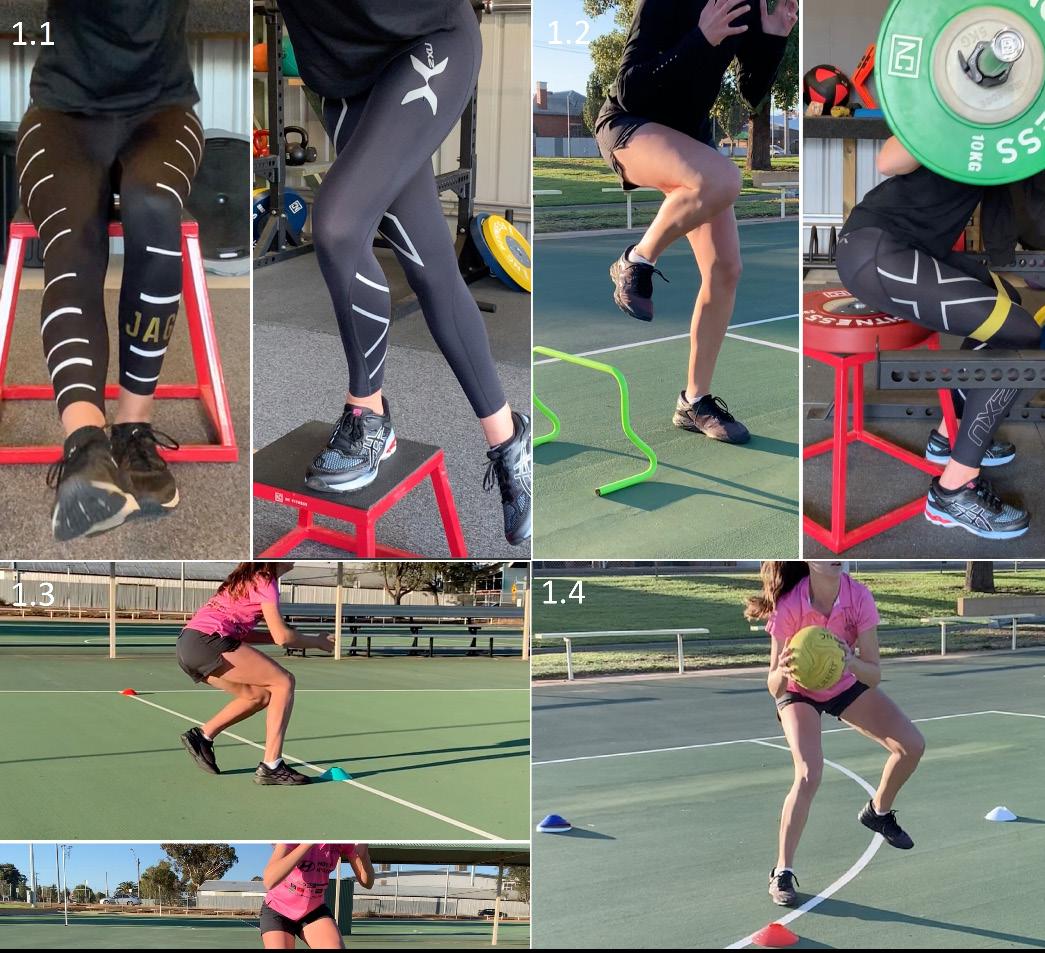
Figure 1: Phases 1 to 4 of non-surgical ACLRu rehabilitation. Phase 1 focuses on initial strength and neuromuscular control; phase 2 continues to build strength, encourages muscle hypertrophy and introduces running and plyometrics; phase 3 includes sport-specific skills, emphasising agility, changes of direction, cutting and coordination; phase 4, the RTP phase, sees a gradual return to training and competition
Please see Bibby and Tripodi (2021) for more detail on phase progression criteria and timeframes.
Given the nature of ACLRu injuries, it’s not uncommon for an athlete to experience setbacks along their RTP journey. The coper classification system is generally accurate, but athletes can still sometimes require ACLRe despite initially being classified as a coper.18 Referral to an orthopaedic surgeon will be the main course of action for an osteopath if an athlete in their care fails to heal with non-surgical management and becomes a non-coper.
Non-surgical management of ACLRu is an emerging area of research and clinical practice and there is some evidence to show that for certain patients there may be some advantages when compared to the traditional surgical approach. Osteopaths with experience and a special interest in this area can play an important
role in the team care approach, and help patients with their decision-making process. Regardless of the approach a patient chooses to take, the risks, benefits and likelihood of RTP must be discussed with all ACLRu athletes. Despite the current literature base describing some potential benefits of non-surgical ACLRu management, more research is required to further elucidate these findings.
Post-script: our experience with ACL self-healing
In the case documented by Bibby and Tripodi (2021), a 15-year old netballer underwent a non-surgical management for an ACLRu. Two years following, the then 17-year-old was reassessed, where repeat MRI findings showcased evidence of healing. The ACL appeared continuous and structurally intact, albeit slightly attenuated and scarred. Complementing these MRI findings, functional screening and orthopaedic examination were also satisfactory, supporting continued sports participation as the subject was maintaining a routine strength protocol. The natural
A team care approach with early diagnosis and best management of initial knee injury symptoms aims to achieve a quiet (no swelling) and happy (no pain or apprehension) knee. This includes early introduction of rehabilitation (Phase 1), helps prepare a patient for potential coper screening, or alternatively enhances knee health and strength preoperatively for better postoperative outcomes. No two ruptures are ever the same. Symptoms can vary widely from patient to patient. After early rehabilitation, individual patients may or may not be classified as a coper (see Table 1). Decision-making about surgical vs. non-surgical rehabilitation is highly dependent on what athletic level the patient wants to return to on recovery from their injury. If there are no constraints, tight timeframes, and/or strong desires to return to preinjury states, conservative management is certainly a viable strategy. Surgery can always be performed if the knee fails to heal. An unhappy knee that continues to be painful and swollen and struggles to perform functional testing, with continued instances of giving way, should be referred for a surgical opinion (anywhere up to 3-6 months typically).
ligament healing was unexpected and underscores the potential of nonsurgical approaches in specific cases. Furthermore, the absence of meniscal tears and the preservation of cartilage integrity reinforced the positive structural outcome. The athlete had successfully resumed competitive activities in netball, tennis and basketball with minimal discomfort, which validated the efficacy of the non-surgical strategy employed.
References on page 30
Anterior cruciate ligament rupture: considering a non-surgical management approach, by Louise Bibby and Nicholas Tripodi, p26-29
1. Filbay, S., Roemer, F., Lohmander, S., Turkiewicz, A., Roos, E. M., Frobell, R., & Englund, M. (2022). 32 Spontaneous healing of the ruptured anterior cruciate ligament: observations from the KANON trial. In: BMJ Specialist Journals.
2. Zbrojkiewicz, D., Vertullo, C., & Grayson, J. E. (2018, May 7). Increasing rates of anterior cruciate ligament reconstruction in young Australians, 20002015. Med J Aust, 208(8), 354-358. https://doi.org/ https://doi.org/10.5694/mja17.00974
3. Zebis, M. K., Warming, S., Pedersen, M. B., Kraft, M. H., Magnusson, S. P., Rathcke, M., Krogsgaard, M., Døssing, S., & Alkjær, T. (2019). Outcome Measures After ACL Injury in Pediatric Patients: A Scoping Review. Orthopaedic journal of sports medicine, 7(7), 2325967119861803.
4. Abram, S. G., Price, A. J., Judge, A., & Beard, D. J. (2020). Anterior cruciate ligament (ACL) reconstruction and meniscal repair rates have both increased in the past 20 years in England: hospital statistics from 1997 to 2017. British Journal of Sports Medicine, 54(5), 286-291.
5. Bibby, L., & Tripodi, N. (2021). Non-surgical management and return to play of an anterior cruciate ligament rupture: A case report. International Journal of Osteopathic Medicine.
6. Filbay, S. R., Dowsett, M., Jomaa, M. C., Rooney, J., Sabharwal, R., Lucas, P., Van Den Heever, A., Kazaglis, J., Merlino, J., & Moran, M. (2023). Healing of acute anterior cruciate ligament rupture on MRI and outcomes following non-surgical management with the Cross Bracing Protocol. British Journal of Sports Medicine, 57(23), 1490-1497.
7. Ardern, C. L., Taylor, N. F., Feller, J. A., & Webster, K. E. (2014). Fifty-five per cent return to competitive sport following anterior cruciate ligament reconstruction surgery: an updated systematic review and meta-analysis including aspects of physical functioning and contextual factors. British Journal of Sports Medicine, 48(21), 1543-1552. https://doi.org/ https://doi.org/10.1136/bjsports-2013-093398
8. Lai, C. C. H., Ardern, C. L., Feller, J. A., & Webster, K. E. (2018, Jan). Eighty-three per cent of elite athletes return to preinjury sport after anterior cruciate ligament reconstruction: a systematic review with meta-analysis of return to sport rates, graft rupture rates and performance outcomes. Br J Sports Med, 52(2), 128-138. https://doi.org/https://doi.org/10.1136/ bjsports-2016-096836
9. Paterno, M. V., Rauh, M. J., Schmitt, L. C., Ford, K. R., & Hewett, T. E. (2014, Jul). Incidence of Second ACL Injuries 2 Years After Primary ACL Reconstruction and Return to Sport. Am J Sports Med, 42(7), 1567-1573. https://doi.org/https://doi. org/10.1177/0363546514530088
10. Zadro, J. R., & Pappas, E. (2019, Mar). Time for a Different Approach to Anterior Cruciate Ligament Injuries: Educate and Create Realistic Expectations. Sports Med, 49(3), 357-363. https://doi.org/https://doi. org/10.1007/s40279-018-0995-0
11. Frobell, R. B., Roos, H. P., Roos, E. M., Roemer, F. W., Ranstam, J., & Lohmander, L. S. (2013). Treatment for acute anterior cruciate ligament tear: five year outcome of randomised trial. Bmj, 346, f232. https:// doi.org/https://doi.org/10.1136/bmj.f232
12. Hurd, W. J., Axe, M. J., & Snyder-Mackler, L. (2008, Jan). A 10-year prospective trial of a patient management algorithm and screening examination for highly active individuals with anterior cruciate ligament
injury: Part 2, determinants of dynamic knee stability. Am J Sports Med, 36(1), 48-56. https://doi.org/https:// doi.org/10.1177/0363546507308191
13. Keays, S. L., Newcombe, P., & Keays, A. C. (2019). Nearly 90% participation in sports activity 12 years after non-surgical management for anterior cruciate ligament injury relates to physical outcome measures. Knee Surgery, Sports Traumatology, Arthroscopy, 27(8), 2511-2519. https://doi.org/https://doi.org/10.1007/ s00167-018-5258-y
14. Myklebust, G., Holm, I., Maehlum, S., Engebretsen, L., & Bahr, R. (2003, Nov-Dec). Clinical, functional, and radiologic outcome in team handball players 6 to 11 years after anterior cruciate ligament injury: a follow-up study. Am J Sports Med, 31(6), 981989. https://doi.org/https://doi.org/10.1177/036354650 30310063901
15. Weiler, R., Monte-Colombo, M., Mitchell, A., & Haddad, F. (2015). Non-operative management of a complete anterior cruciate ligament injury in an English Premier League football player with return to play in less than 8 weeks: applying common sense in the absence of evidence. Case Reports, 2015, bcr2014208012. https://doi.org/https://doi.org/10.1136/ bcr-2014-208012
16. Button, K., van Deursen, R., & Price, P. (2006). Classification of functional recovery of anterior cruciate ligament copers, non-copers, and adapters. British Journal of Sports Medicine, 40(10), 853-859. https://doi. org/https://doi.org/10.1136/bjsm.2006.028258
17. Moksnes, H., Snyder-Mackler, L., & Risberg, M. A. (2008, Oct). Individuals With an Anterior Cruciate Ligament-Deficient Knee Classified as Noncopers May Be Candidates for Nonsurgical Rehabilitation. journal of orthopaedic & sports physical therapy, 38(10), 586-595. https://doi.org/https://doi.org/10.2519/ jospt.2008.2750
18. Thoma, L. M., Grindem, H., Logerstedt, D., Axe, M., Engebretsen, L., Risberg, M. A., & SnyderMackler, L. (2019, Mar). Coper Classification Early After Anterior Cruciate Ligament Rupture Changes With Progressive Neuromuscular and Strength Training and Is Associated With 2-Year Success: The DelawareOslo ACL Cohort Study. American Journal of Sports Medicine, 47(4), 807-814. https://doi.org/https://doi. org/10.1177/0363546519825500
19. Eitzen, I., Moksnes, H., Snyder-Mackler, L., & Risberg, M. A. (2010). A progressive 5-week exercise therapy program leads to significant improvement in knee function early after anterior cruciate ligament injury. journal of orthopaedic & sports physical therapy, 40(11), 705-721. https://doi.org/https://doi.org/10.2519/ jospt.2010.3345
20. Failla, M. J., Logerstedt, D. S., Grindem, H., Axe, M. J., Risberg, M. A., Engebretsen, L., Huston, L. J., Spindler, K. P., & Snyder-Mackler, L. (2016). Does extended preoperative rehabilitation influence outcomes 2 years after ACL reconstruction? A comparative effectiveness study between the MOON and Delaware-Oslo ACL cohorts. The American journal of sports medicine, 44(10), 2608-2614. https://doi.org/ https://doi.org/10.1177/0363546516652594
21. Finch, C. F., Twomey, D. M., Fortington, L. V., Doyle, T. L., Elliott, B. C., Akram, M., & Lloyd, D. G. (2016, Apr). Preventing Australian football injuries with a targeted neuromuscular control exercise programme: comparative injury rates from a training intervention delivered in a clustered randomised controlled trial. Inj Prev, 22(2), 123-128. https://doi.org/https://doi. org/10.1136/injuryprev-2015-041667
22. Harput, G., Ulusoy, B., Yildiz, T. I., Demirci, S., Eraslan, L., Turhan, E., & Tunay, V. B. (2019, Jan). Cross-education improves quadriceps strength recovery after ACL reconstruction: a randomized controlled trial. Knee Surg Sports Traumatol Arthrosc, 27(1), 68-75. https://doi.org/https://doi.org/10.1007/s00167018-5040-1
23. Rossler, R., Donath, L., Verhagen, E., Junge, A., Schweizer, T., & Faude, O. (2014, Dec). Exercisebased injury prevention in child and adolescent sport: a systematic review and meta-analysis. Sports Med, 44(12), 1733-1748. https://doi.org/https://doi. org/10.1007/s40279-014-0234-2
24. Kristianslund, E., Faul, O., Bahr, R., Myklebust, G., & Krosshaug, T. (2014, May). Sidestep cutting technique and knee abduction loading: implications for ACL prevention exercises. Br J Sports Med, 48(9), 779-783. https://doi.org/https://doi.org/10.1136/ bjsports-2012-091370
25. Filbay, S. R., & Grindem, H. (2019, Feb). Evidence-based recommendations for the management of anterior cruciate ligament (ACL) rupture. Best Pract Res Clin Rheumatol, 33(1), 33-47. https://doi.org/ https://doi.org/10.1016/j.berh.2019.01.018
Rehabilitating Olympic athletes: the strategies for success, by Jason Izydorzcyk p24-25
1. Edouard P, Ford KR. Great challenges toward sports injury prevention and rehabilitation. Frontiers in Sports and Active Living. 2020 Jul 3;2. doi:10.3389/fspor.2020.00080
2. Soligard T, Schwellnus M, Alonso J-M, Bahr R, Clarsen B, Dijkstra HP, et al. How much is too much? (part 1) International Olympic Committee Consensus statement on load in sport and risk of injury. British Journal of Sports Medicine. 2016 Aug 17;50(17):1030–41. doi:10.1136/bjsports-2016-096581
3. [Internet]. 2019 [cited 2024 May 2]. Available from: https://olympics.com/ioc/news/tackling-mental-healthin-olympic-sport
4. Weiß M, Büttner M, Richlan F. The role of Sport Psychology in Injury Prevention and Rehabilitation in junior athletes. Behavioral Sciences. 2024 Mar 20;14(3):254. doi:10.3390/bs14030254
5. Papadopoulou SK. Rehabilitation nutrition for injury recovery of athletes: The role of macronutrient intake. Nutrients. 2020 Aug 14;12(8):2449. doi:10.3390/nu12082449
6. Frevel N, Beiderbeck D, Schmidt SL. The impact of technology on sports – a prospective study. Technological Forecasting and Social Change. 2022 Sept;182:121838. doi:10.1016/j.techfore.2022.121838
7. Rossi A, Pappalardo L, Cintia P. A narrative review for a machine learning application in sports: An example based on injury forecasting in soccer. Sports. 2021 Dec 24;10(1):5. doi:10.3390/sports10010005
8. Amendolara A, Pfister D, Settelmayer M, Shah M, Wu V, Donnelly S, et al. An overview of machine learning applications in sports injury prediction. 2022 Nov 16; doi:10.51224/srxiv.220
9. Fiscutean A. Data scientists are predicting sports injuries with an algorithm. Nature. 2021 Mar 31;592(7852). doi:10.1038/d41586-021-00818-1
10. Kane LT, Thakar O, Jamgochian G, Lazarus MD, Abboud JA, Namdari S, et al. The role of telehealth as a platform for postoperative visits following rotator cuff repair: A prospective, randomized controlled trial. Journal of Shoulder and Elbow Surgery. 2020 Apr;29(4):775–83. doi:10.1016/j.jse.2019.12.004
11. Chen Y-P, Lin C-Y, Tsai M-J, Chuang T-Y, Lee OK-S. Wearable motion sensor device to facilitate rehabilitation in patients with shoulder adhesive capsulitis: Pilot study to assess feasibility. Journal of Medical Internet Research. 2020 Jul 23;22(7). doi:10.2196/17032
12. Louis M, Guillot A, Maton S, Doyon J, Collet C. Effect of imagined movement speed on subsequent motor performance. Journal of Motor Behavior. 2008 Mar;40(2):117–32. doi:10.3200/jmbr.40.2.117-132
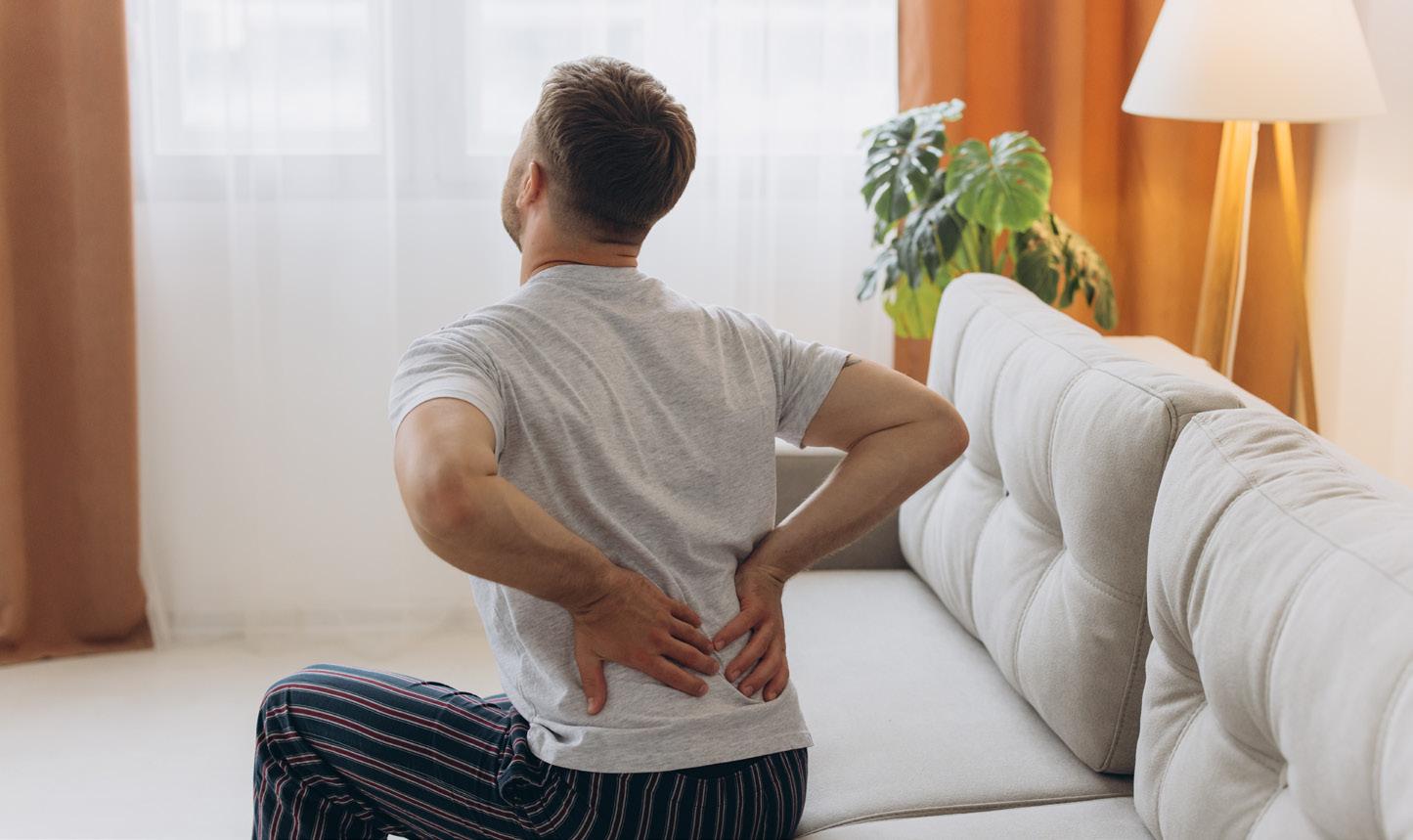
In Australia, musculoskeletal conditions rank as the second leading contributor to all causes of the burden of disease behind cardiovascular disease.1,2 According to the Global Burden of Disease study (2019), the prevalence of low back pain in Australia was estimated at 2.7 million people.1,3 Low back pain is the leading cause of lost years of productivity,4 and the main contributor to the burden of disability.
In osteopathy, a primary goal is to alleviate pain and restore functionality through an individualised, holistic approach, promoting faster recovery. A clinical tool to assist this is the integration of heat wraps into our clinical practice. Heat wraps are used in major hospitals across Australia to manage low back pain, facilitating movement, and assisting faster recovery by promoting local blood flow and reducing the pain barrier to movement.
Heat wraps are recommended in the Australian Clinical Care Standard for low back pain
The new Australian Clinical Care Standard for Low Back Pain5 recommends heat wraps and movement as interventions for managing low back pain. This supports osteopaths’ clinical decision to incorporate heat wraps into their patient management plans and self-management recommendations.
What are heat wraps?
Heat wraps are an Osteopathy Australia (OA) endorsed, evidence-based, superficial heat within a flexible, lightweight fabric wrap designed for the low back. They provide a safe, continuous low-level heat of 40-45 Degrees Celsius for up to 12 hours. Heat wraps contain air-activated and eco-friendly ingredients that release heat uniformly.
How to incorporate heat wraps into your osteopathic practice
Following osteopathic care, applying a heat wrap in the treatment room provides patients with low-level superficial heat for up to 12 hours. Osteopaths can guide patients on proper placement and ensure the wrap covers the affected area adequately. Heat wraps are placed in treatment rooms for direct osteopath application and reception areas for patients to access so that they have refills for their heat wrap to continue treatment with self-management at home.
Clinical implementation
Accessibility: Ensure heat wraps are readily available in treatment rooms for practitioners to apply and in reception areas for patients to access for self-management. Application: Guide patients in activating the heat wrap and positioning it correctly post-treatment, emphasising the benefits of movement, superficial heat and correct use.

Education: Educate patients on how heat wraps can enhance their treatment and promote recovery from low back pain. Precaution: Adhere to the instructions regarding precautionary measures, such as avoiding sleeping with the heat wrap or using it in combination with other heat sources or creams.
Benefits and evidence-based support Heat wraps provide localised heat, targeting the area of pain. They promote vasodilation, increasing blood circulation to muscles and reducing muscle tension. This increased blood flow aids the removal of metabolic waste products to accelerate the healing process. The heat wrap stimulates sensory receptors, blocking pain signals and triggering the release of endorphins, natural pain-relieving chemicals. The effectiveness of heat wraps in LBP management is supported by multiple clinical studies.6 A 2021 review6 concluded that superficial heat (heat wrap) is an effective, safe, and cost-effective non-pharmacological option for low back pain relief.
Find out more
For further information or to access a Free Clinic Sample Pack for your practice email info@flexeze.com.au or call 03 9727 1693.
1. de Luca K, Briggs AM, French SD, Ferreira ML, Cross M, Blyth F, et al. Disability burden due to musculoskeletal conditions and low back pain in Australia: findings from GBD 2019. Chiropr Man Therap. 2022;30(1):22.
2. AIHW. Australian burden of disease study 2023. Australian institute of health and welfare; 2023.
3. The cost of pain in Australia. Pain Australia: Deloitte Access Economics; 2019.
4. Worldbank.org. [Available from: www.worldbank. org/en/topic/disability.
5. Australian Commission on Safety and Quality in Health Care: Low Back Pain Clinical Care Standard. Sydney 2022.
6. Freiwald J, Magni A, Fanlo-Mazas P, Paulino E, Sequeira de Medeiros L, Moretti B, et al. A Role for Superficial Heat Therapy in the Management of NonSpecific, Mild-to-Moderate Low Back Pain in Current Clinical Practice: A Narrative Review. Life (Basel). 2021;11(8).
Ankle injuries are prevalent among athletes, especially those participating in sports that involve rapid movements, sudden stops and changes in direction. As an osteopath, understanding the role of ankle bracing in injury prevention and rehabilitation is crucial. In this article we explore the benefits of ankle bracing, the different types available, and how they can be effectively utilised to treat sporting injuries.
The function of ankle braces
Ankle braces serve several essential functions during injury recovery and prevention. Recent literature suggests that the use of ankle bracing is just as effective as taping, with benefits of compliance and cost effectiveness.
• Support and stabilisation: Ankle braces provide compression and stabilisation to the ankle joint. They help maintain proper alignment in the coronal plane and prevent excessive movement during physical activity.
• Injury prevention: By restricting inversion and eversion ankle movements, braces reduce the risk of both first-time and recurring ankle sprains. They act as a protective barrier, preventing ligament strain and muscle damage.
• Performance enhancement: Ankle braces improve proprioception and increase stability in previously injured joints, allowing athletes to compete with confidence.
As an osteopath, you’ll encounter various types of ankle braces. Understanding their features and indications will help you recommend the most suitable option for your patients:
• Ankle sleeves or elastic support:
o Lightweight and ideal for minor aches/soreness or swelling;
o Allow full ankle range of motion while providing compression and slight support;
o Commonly used for stiff, weak or sore ankles.
• Figure 8 ankle braces (lace-up):
o Adjustable to be able to tailor amount of support needed;
o Use a criss-cross figure-8 strapping style similar to ankle taping;
o Simplistic design for ease of use.
• Figure 8 ankle braces (non-lace-up):
o Customisable to individual athletes and support needed;

o Use a criss-cross figure-8 strapping style similar to ankle taping;
o Slim design features to be able to fit in athletic shoes;
o Convenient for removal and application.
Remember to consider your patients’ specific needs, budget and material preferences when recommending ankle braces. Whether it’s preventing injuries or aiding recovery, OPC Health has the right solution for your practice.
As an osteopath, incorporating ankle bracing into your treatment plans can significantly enhance patient outcomes. Stay informed about the latest advancements in ankle brace technology and continue to provide evidence-based recommendations to your patients. Together, we can promote safer and more effective sports participation for athletes of all levels.

OPC Health has been a dedicated provider of bracing and orthotic products to the Australian allied health industry for over 40 years. As an osteopath, you can rely on OPC Health for quality ankle braces and expert advice. Here are some of the ankle braces available:
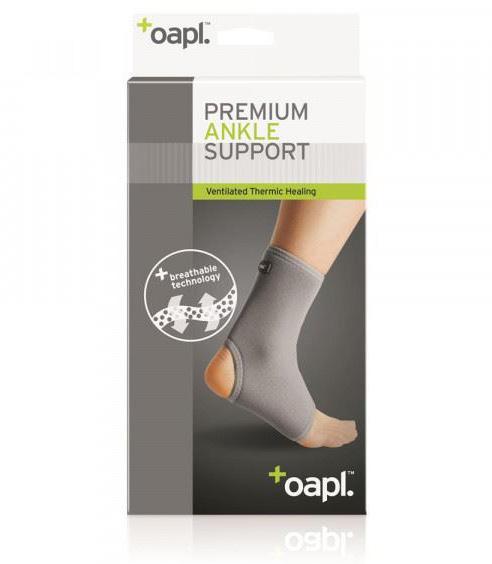
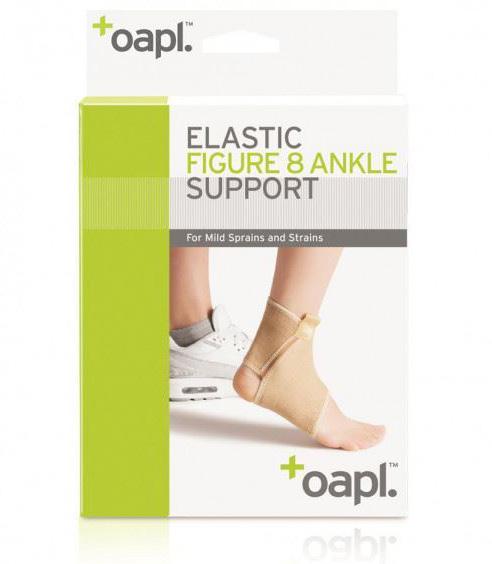
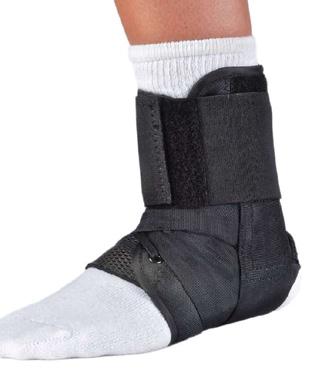
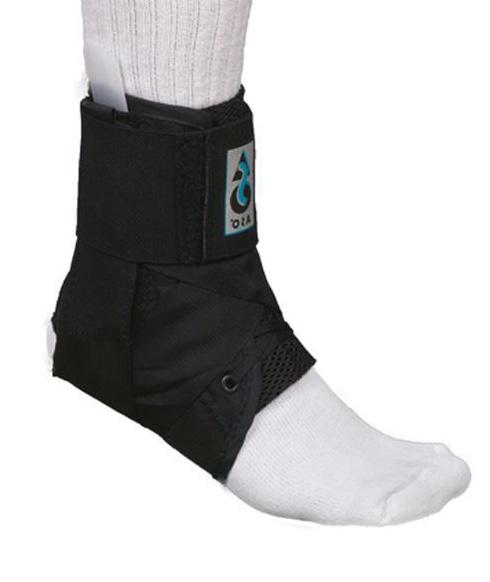



Leading sports osteopath Dr Paul Hermann shares his 20-year journey working with athletes, offering insights and inspiration for those seeking a dynamic career in sports osteopathy.
I was very honoured and humbled when asked by Osteopathy Australia to write about my experience working with athletes and sporting teams. It has been a wonderful experience thinking back through more than 20 years of working in this space. I’m also regularly inspired by the many other osteopaths who work with athletes in tennis, golf, AFL, basketball, martial arts and more. I love watching their successes that continue to promote our amazing profession and the benefits of osteopathy. I remain grateful daily to continue the work I love with my amazing team and inspiring patients. Here’s a snapshot of the memorable moments of my journey thus far and a few lessons I learnt along the way.
I was a fourth-year osteo student at VU and took up the opportunity to volunteer at the 2000 Paralympics. It was an amazing experience. The energy, the inspiring athletes, and learning how elite sport works behind the scenes. We received no wage, paid for our travel and accommodation, and took time from our jobs, yet the balance of equations was still in our favour, as the experience we had and the things we learnt made it well worth it.
As a fresh, newly graduated osteopath, I jumped at the unique opportunity to work with elite skiers and snowboarders in Niseko. I spent several weeks there in 2002 and again in 2003, treating and providing exercise and performance advice to the elite professionals and tourists experiencing the amazing snow (and sometimes bonecrushing trees) in this winter wonderland. After referring several people to the local hospital, I was lucky enough (with the help of a translator) to run a lecture at the hospital

in Sapporo talking about osteopathy and learning all I could about the local medical system. I was paid with a lift pass, a sack of peanuts (true) and some tips from tourists, but the experience was payment itself.
After incidentally looking after some of the pit crew at my clinic in Elwood, I was fortunate to be asked to be the osteopath for Britek Motorsport, working with V8 Supercar drivers, including Jason Bright. I knew very little about motorsport, but I relished the opportunity and challenge to learn about its demands and develop exercise programs for the drivers, pit crew and support team. I also worked with the engineers, discussing the various forces and biomechanical considerations that each track uniquely placed upon the drivers and adapted their exercise programs accordingly. Managing on-thespot consults in a challenging, loud and busy pit helped me think fast and adapt while appreciating the most amazing tools we have, our knowledge and our hands.
2015: My involvement in beach volleyball was growing and I treated many Victorianbased players. A coach approached me to work with Damien Schumann and Josh Court’s teams. I’d seen these lads playing and was in awe of their skill and attitude. They embodied hard work and resilience.
2016: Despite many challenges, team Schumann/Court won every national tour event that year. Beach volleyball is not a well-paid sport, so I travelled around supporting and helping these players off my own back, enjoying it all.
2017: Among the beach volleyball players I supported nationally and internationally
DR PAUL HERMANN
Dr Paul Hermann is an Osteopathy
Australia Titled Advanced Sports osteopath, Advanced Exercise Rehabilitation osteopath and exercise/sports scientist.
was another great athlete, Carrie van Rensburg. Through many challenges and persistent hard work, Carrie fought her way to the Junior Commonwealth Games and became a gold medallist.
2018: Three years after starting to support Schumann, I screamed for joy as he won Commonwealth gold. One of the best experiences in my career was watching he and his partner, Chris McHugh, achieve this after so many years of arduous work.
Over the years, I’ve also been lucky to have worked on a sessional basis with NBL basketball teams and helped prepare Ironman competitors, marathon champions, elite triathletes, professional gymnasts, stunt people, and amateur weekend warriors. Working with these athletes reminds me success requires hard work, resilience, perseverance and unyielding belief. I’ve learnt so much technically from the challenges of working in cramped spaces, outdoors, under marquees in the rain, on sand without a treatment table, under pressure and with time constraints. I still have so much to learn and experience, and many wonderful opportunities to come.
After 20 years in this space, my advice is to be open to every opportunity, be prepared to work a lot, often for free, learn from every experience and every other profession, collaborate, ask for help, and stay truly focused on the results of the people you work with. You’ll always come out with that winning feeling.
Key dates for your diary throughout the coming months.
31 JULY 2024 — 7:30PM AEST
Bracing alongside exercise and manual therapy
This webinar will explore the varying options clinicians can utilise when treating patients with osteoarthritis. A key focus will be on the role bracing intervention can play, in conjunction with manual therapy, exercise prescription and pain management.
Presenter: Tom Fitzpatrick – OPC Health Register: Via CPD Hub
4 AUGUST 2024 — 9:30AM – 4:30PM AEST
Advanced rehabilitation in spinal stability
The workshop will teach the latest evidence-based assessments, management and exercise rehabilitation for Functional Spinal Instability which often presents as Chronic Mechanical Low Back Pain.
Presenter: Dual titled Advanced Sports and Advanced Exercise Rehab Osteopath, Paul Hermann
Location: The Prince Charles Hospital
Queensland Register:

30 AUGUST 2024 — 8:30AM – 5:30PM Western Bulldogs Education Athletics Performance Summit
This unique, one-day immersive professional development event for students, strength and conditioning coaches and allied health practitioners who want to elevate their understanding of and ability to impact athletic performance.
Presenters: Led by some of the industry’s most experienced coaches and practitioners Register: Via CPD Hub
4 SEPTEMBER 2024 — 7:30PM AEST Women’s Health Week
Presenter: Beth Yule chairing a female panel Register: Via CPD Hub
18 SEPTEMBER 2024 — 7:30PM AEST
Treating WorkCover and TAC patients in Victoria
Presenter: Alison Sim and Claire Richardson Register: Via CPD Hub
TBA SEPTEMBER
Pain Awareness Month
Presenter: Claire Richardson


Osteopathy Australia works hard to gain professional rights and recognition for osteopaths in Australia through advocacy and political lobbying.

We promote osteopathy in the media, social media and throughout the community to generate positive publicity and raise the public’s awareness and understanding of the profession. PROMOTION

Formal recognition program for osteopaths with additional qualifi cations and advanced skills and experience or osteopaths who have demonstrated extended knowledge and skill.

The 1300 143 602 hotline is a dedicated service for you, whether an associate, employee or business owner, to seek direct advice. A comprehensive online library of technical resources is available exclusively for members; including manuals, policies and template contracts and letters.
Your clinic is listed in our online directory, helping patients find you. Membership to Osteopathy Australia signifi es a standard of professionalism and ethics beyond registration requirements. FIND AN

An exclusive quarterly publication that covers the latest news, trends, policies and events for industry professionals. The magazine is available only to Osteopathy Australia members.

The 1800 467 836 number provides phone guidance and information to our members. We also communicate with hundreds of potential patients every week across Australia.
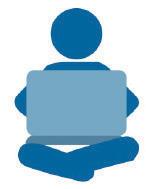
Members can access online, print and face-to-face resources including webinars, eLearning, workshops and events, podcasts, the National Conference and Osteo Life magazine. You get to learn your way.

Take advantage of enhanced professional indemnity insurance at a reduced rate. The enhanced policies include the added benefit of legal advice, public liability and “run o ” cover.

You and your family can save all year on lifestyle, leisure, and financial services with o ers from Coles, Woolworths, The Good Guys, JB Hi-Fi, Specsavers, and more. Access discounts on movie tickets, eGift cards, sports, hotels worldwide, and travel.

Save hundreds on our member exclusive partnerships that cover a range of courses and products essential to your clinical and professional needs.
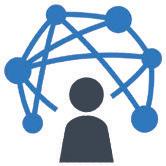
Take advantage of free or discounted advertising options among our wide network. Be featured or browse opportunities on our classifieds web page, Osteo Life publication or regular eFlyers that are distributed among thousands of contacts.

Over 60 years ago, the Pharmacy Guild of Australia launched Guild Insurance – designed to protect and safeguard the pharmacy profession. Since then Guild has expanded the network of professionals we protect by forming partnerships with associations who represent a wide range of industries and the professionals who work within these fields.
Proudly partnering with Osteopathy Australia for over 22 years means we understand the importance of protecting you with more than just a policy.
With us, you’ll be shielded by a policy created from unmatched insight into your profession, access to risk management materials to help you reduce the risk of a claim, backing
from the industry body that stands up for Australian osteopaths, and so much more.
Find out how you can be part of something bigger by visiting: guildne.ws/OsteoLife or calling 1800 810 213 today.